Complete Solutions to illustration of chapter ALKENES AND ALKADIENES of Class 11 book with complete answers and questions
| Class 11 | CHEMISTRY |
| Chapter | ALKENES AND ALKADIENES |
| CENGAGE CHEMISTRY | illustration |
| Number Of Questions | 62 |
| Academic Year | 2023-24 |
Name of the following as substituted derivatives of ethylene.
`(a)` `CH_(3)-CH=CH-CH_(3)`
`(b)` ` CI_(2)C=CHCI`
`(c)` `(CH_(3))_(2)C=CH_(2)`
`(d)` ` (CH_(2)=CH)_(2)C=CH_(2)`
`(e)` `(CH_(2)=CH)-CH=CH-(CH=CH_(2))`
View SolutionWrite the IUPAC names of the following.
a.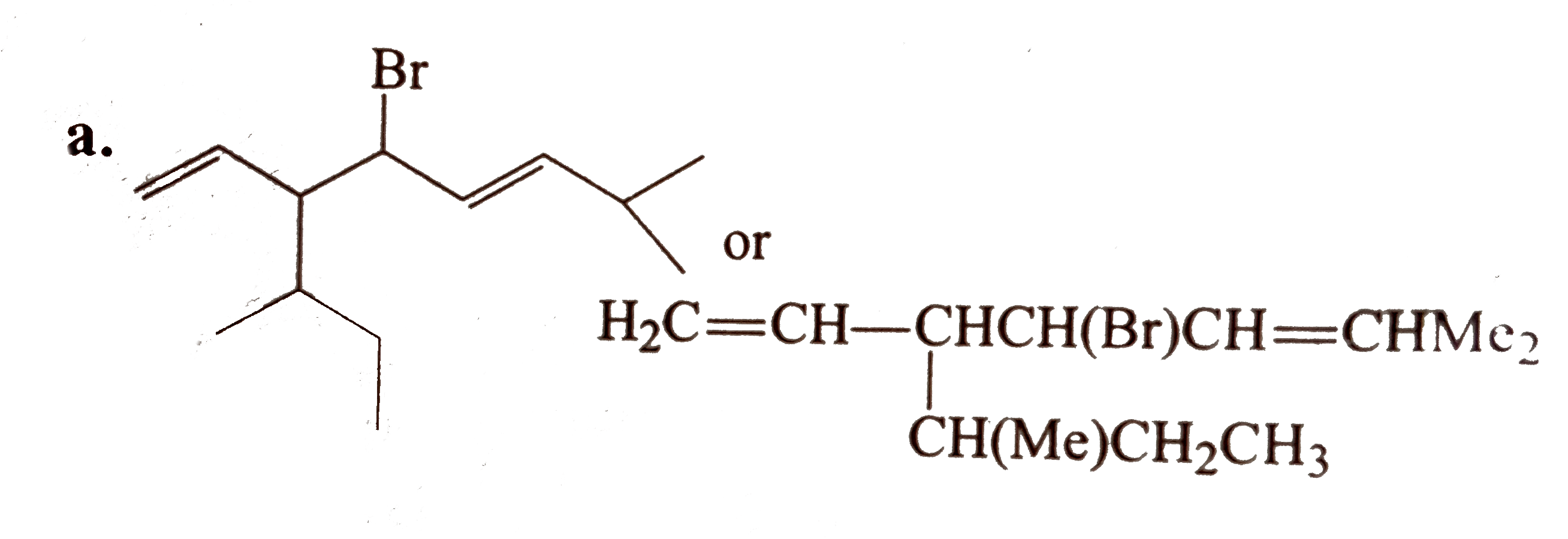
b.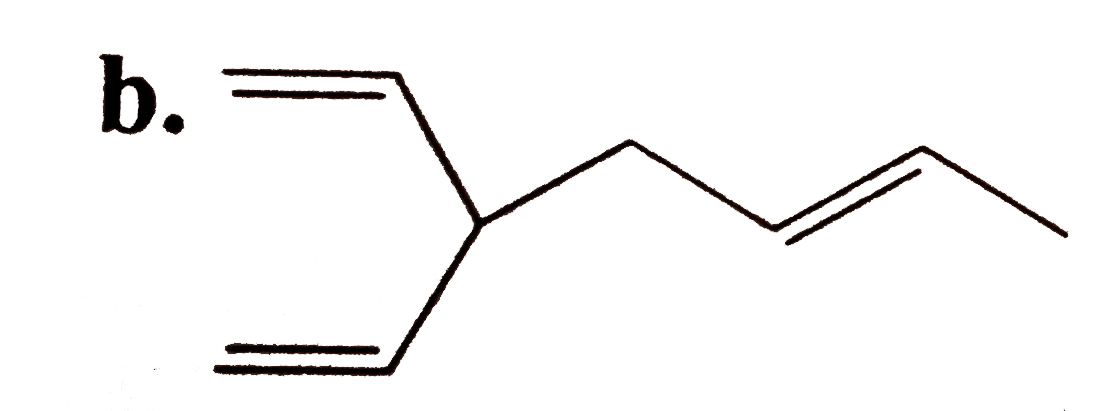 or `(H_(2)C=CH)_(2)CHCH_(2)CH=CHCH_(3)`
or `(H_(2)C=CH)_(2)CHCH_(2)CH=CHCH_(3)`
c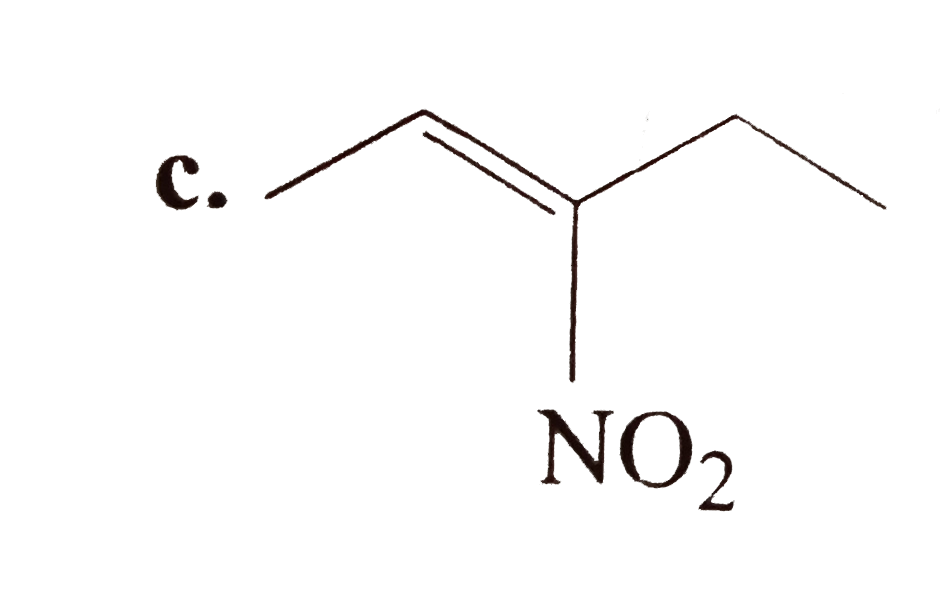 or `CH_(3)CH=C(NO_(2))CH_(2)CH_(3)`
or `CH_(3)CH=C(NO_(2))CH_(2)CH_(3)`
d
e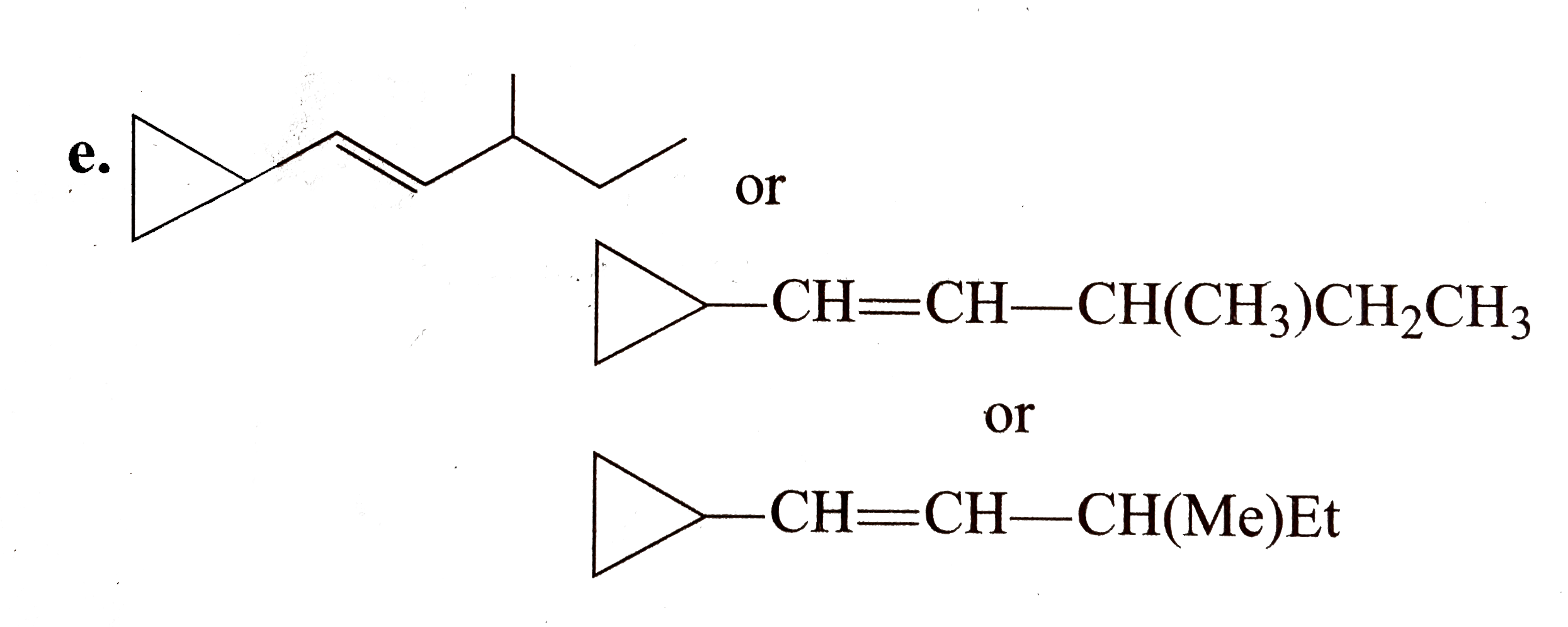
f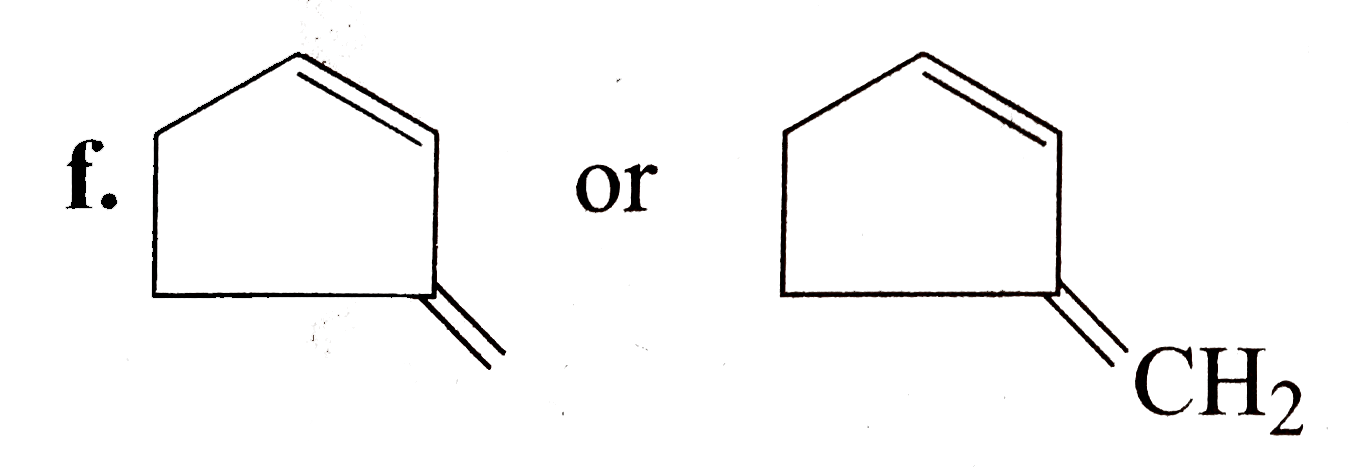
g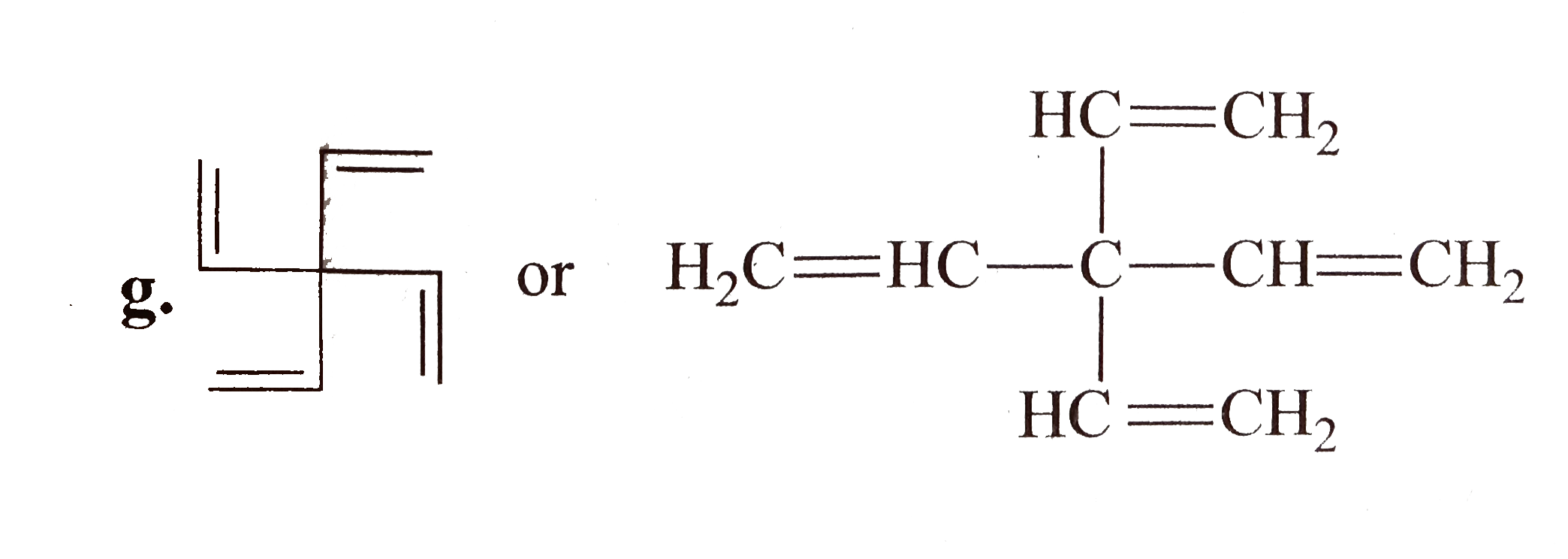
View SolutionWrite the structures of the following compounds.
`a.` `3,7-` Dimethylocta`-1,3,6-` triene
`b.` `4-`Allyl`-3-` propenyl`-1,3-` cyclohexadiene
`c.` `2-` Ethenyl bicyclo `[4.40]-1,5,8-` decatriene
`d.` Bicyclo `[2.2.1]-2,5-` heptadiene
View SolutionWhich of the following compounds shows geometrical isomerism `(G.I.)`?
`a.` But`-2-` ene
`b.` `3-` Methyl but `-2-`enoic acid
`c.` `3-` Methyl pent `-2-` enoic acid
`d.` `3-` Phenyl prop `-2-` enoic acid.
View SolutionWhich of the following do not show `G.I.`?
`a.`
View SolutionFrom the following `G.I.` is shown by `:`
`a.`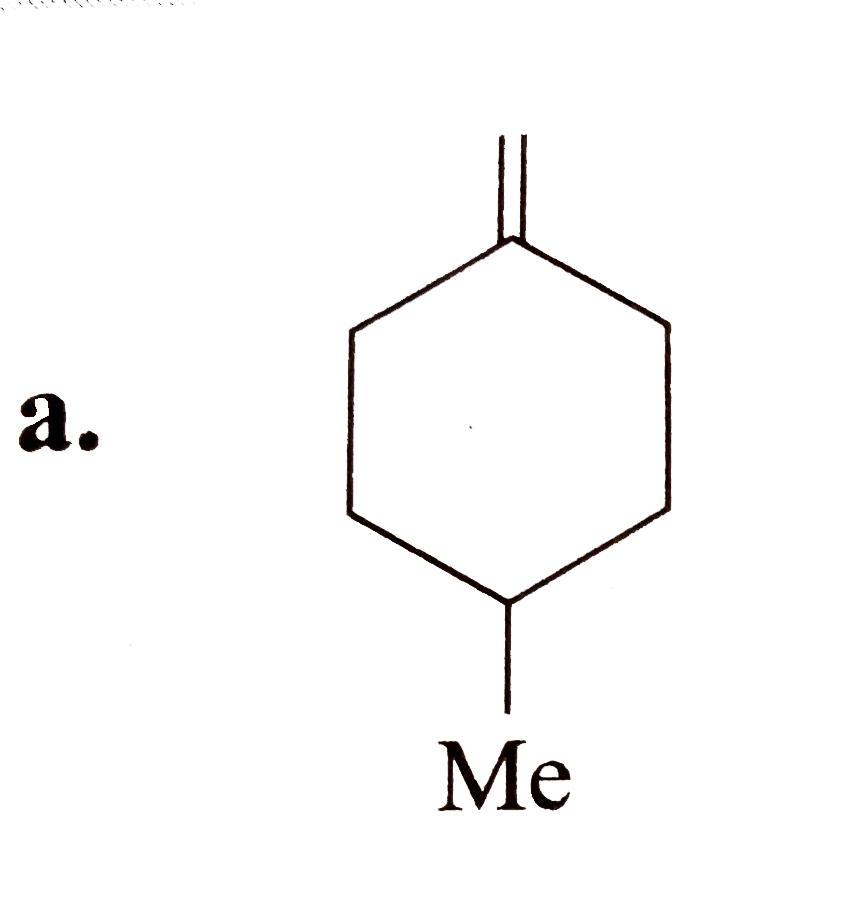 `b.`
`b.` 
`c.`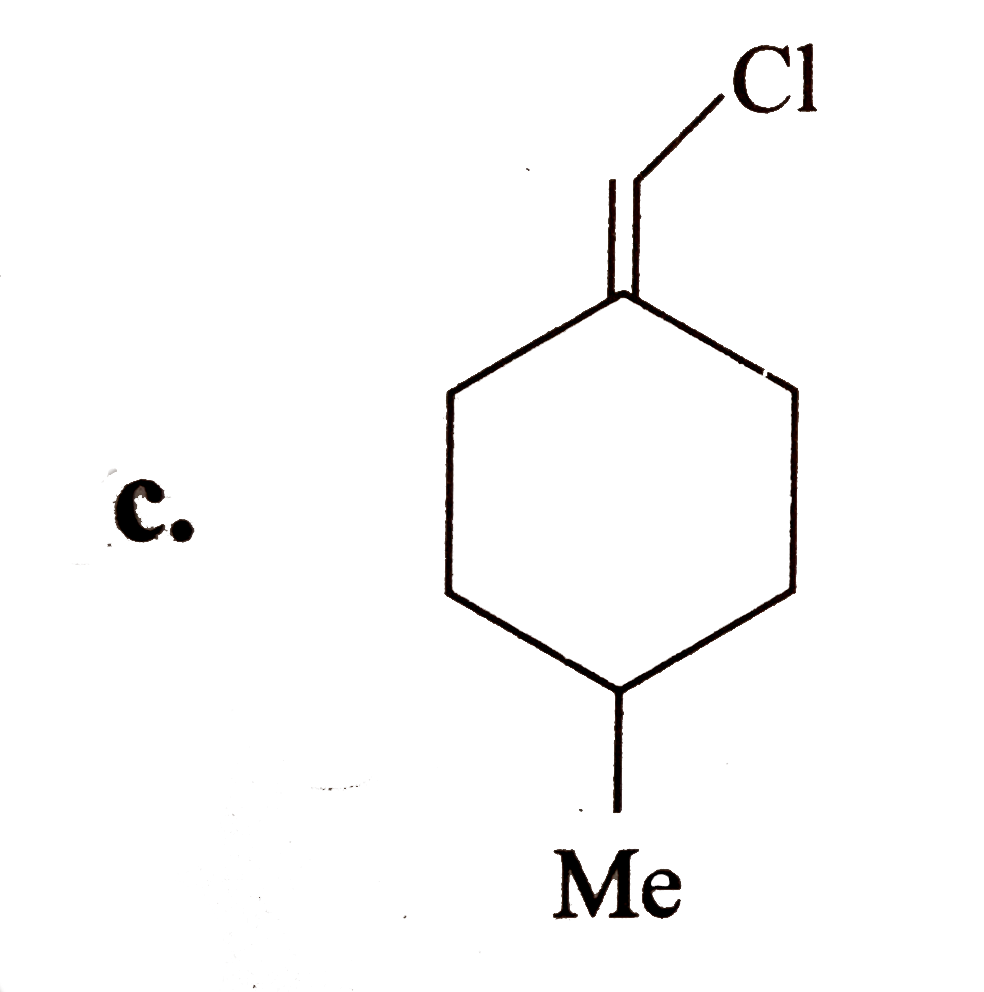 `d.`
`d.` 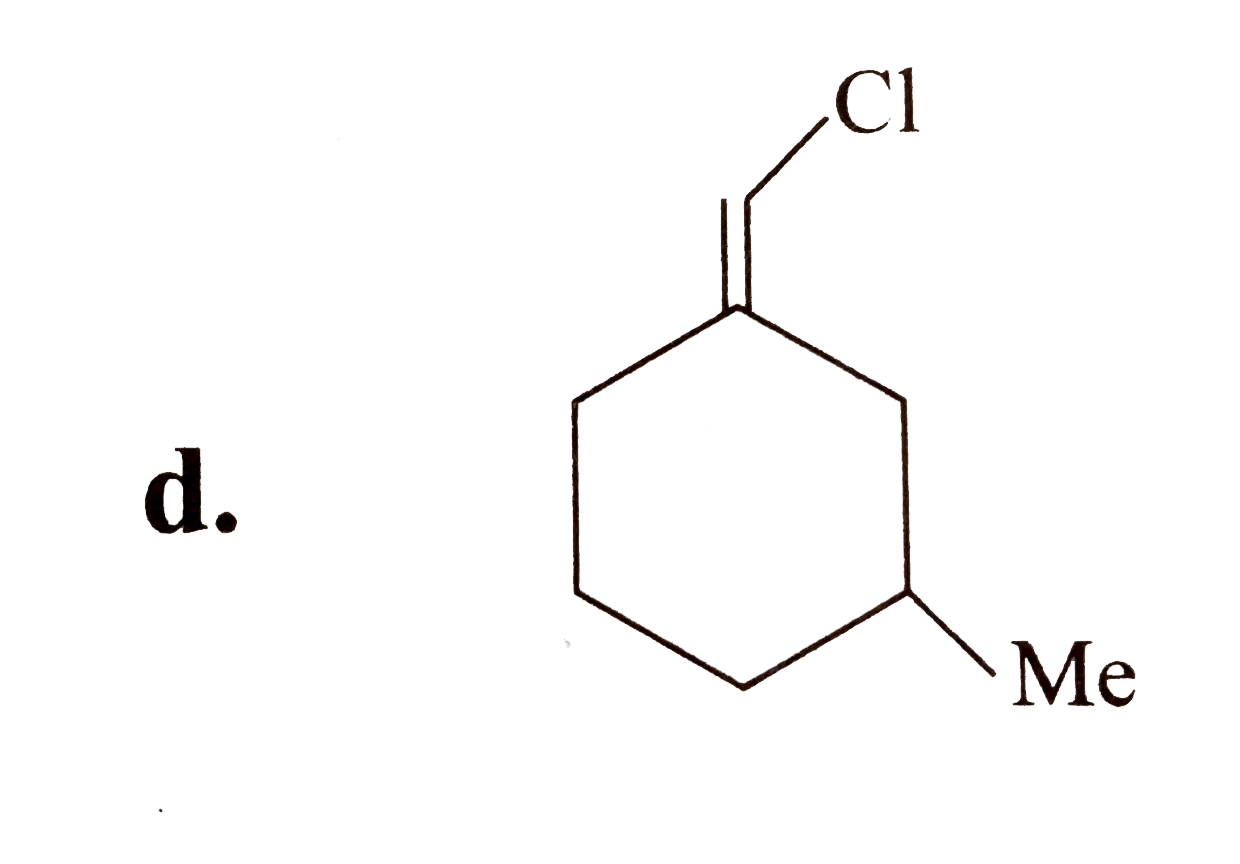
View SolutionDraw all the structural , stereo, and cyclic isomers of `C_(4) H_(6)`.
View SolutionFind the `D.U.` and give the possible structures of following compounds `:`
a. `C_(7)H_(7)CL` that gives blcak soot on burning ?
b. `C_(3)H_(6)O`
c. `C_(3)H_(5)N`
d. `CH_(4)O_(3)S`
View SolutionArrange the following alcohols in the decreasing order of their ease of dehydration with `H_(2)SO_(4)`.
`a.`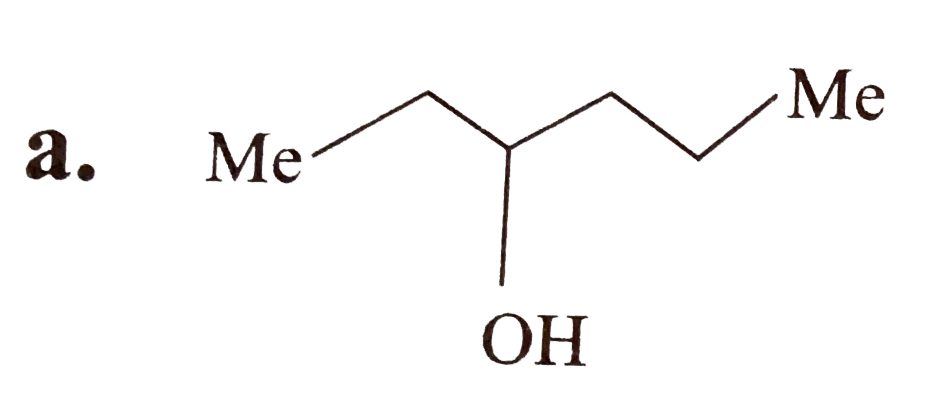
`b.`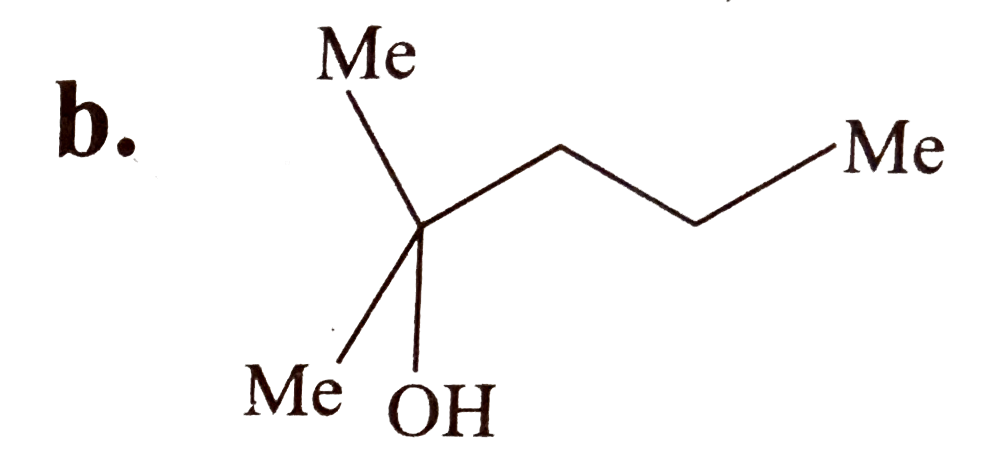
`c.`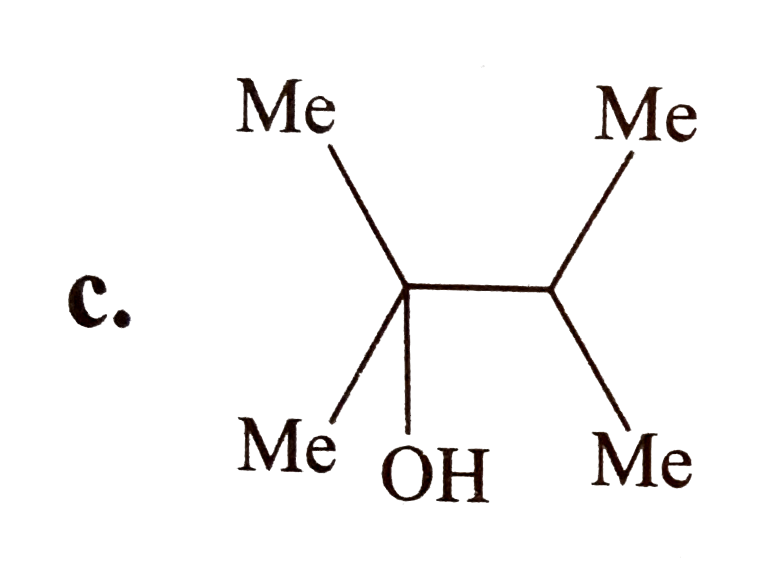
`d.`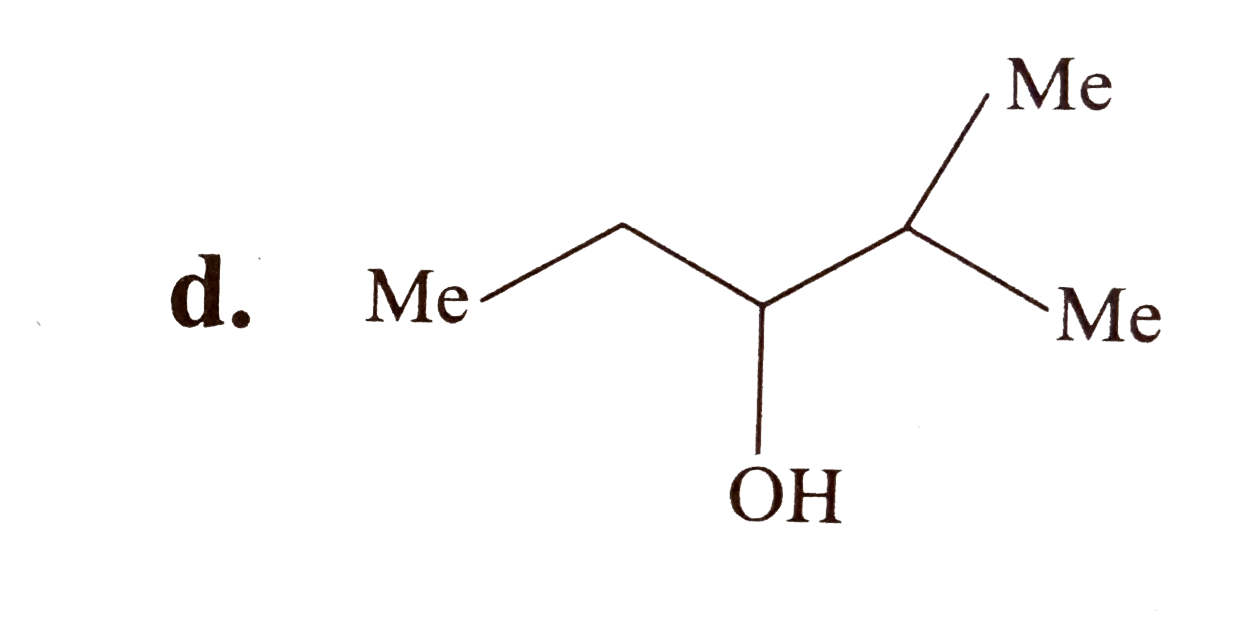
`e.`
View SolutionGive the products of the reaction with conc. `H_(2)SO_(4)` of `:`
`a.`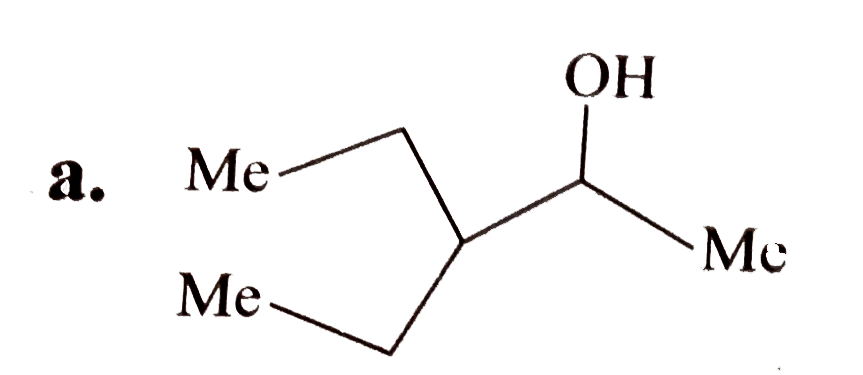
`b.`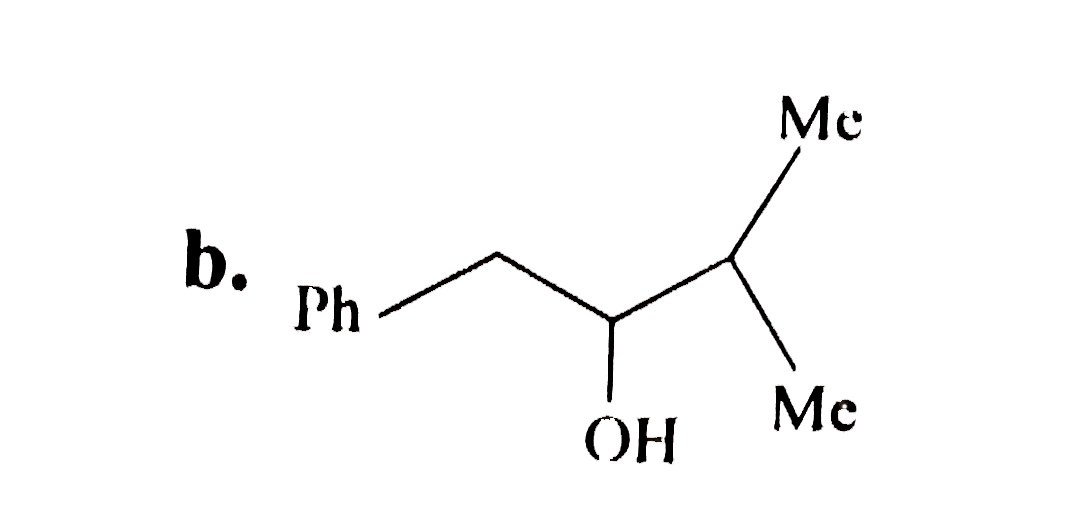
`c.`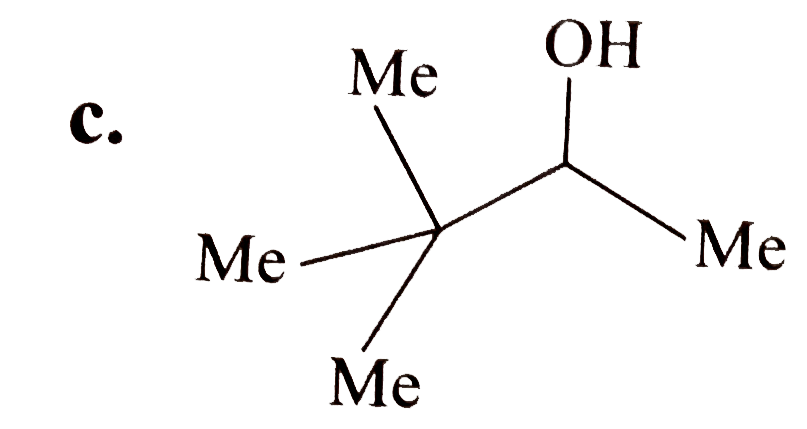
d. 1- Methyl cyclohexanol
View SolutionGive the order of the ease of dehydration and also give the major and minor products of `:`
`a.`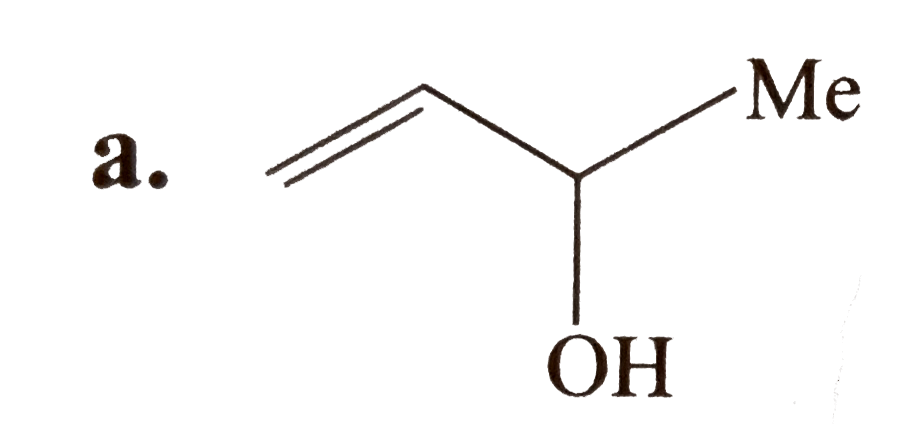
`b.`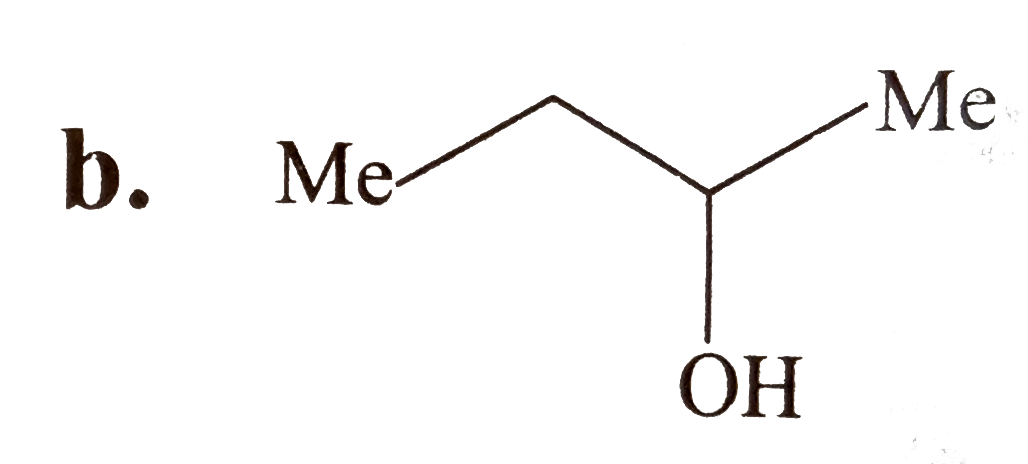
View SolutionGive the major and minor products of the dehydration of the given compound.
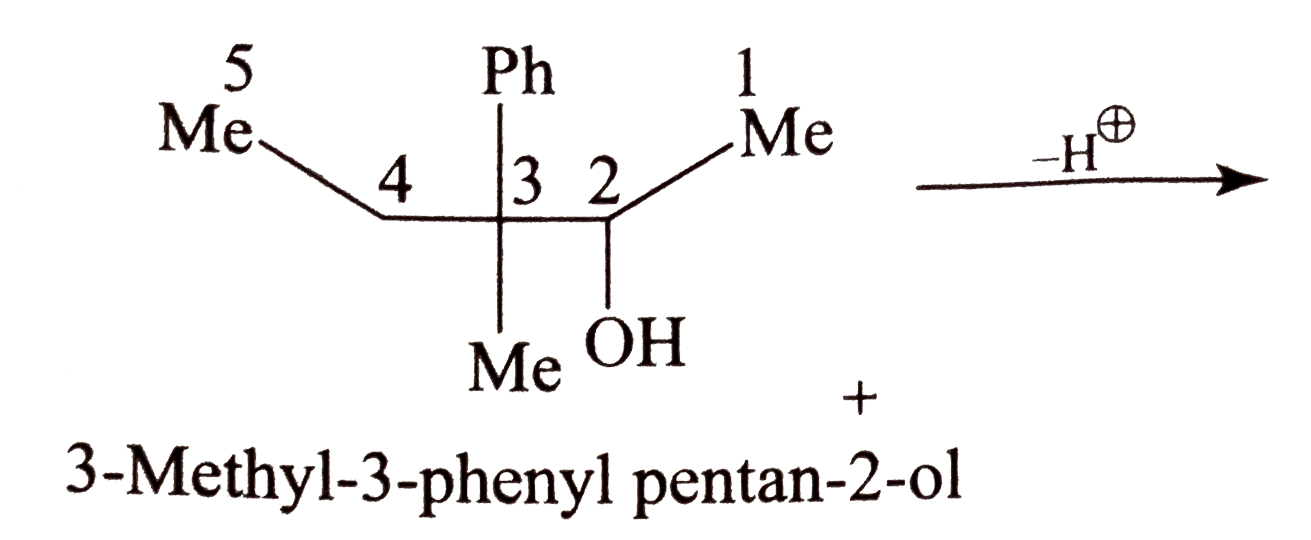
View SolutionIdentify all the possible alkenes that would be formed on the dehydrohalogenation of the following organic halides with alcoholic `KOH`. Also, identify the major alkene.
a. 1- Chloropentane
b. 2- Chloropentane
c. 2-chloro-2-methyl butane
d. 2-Chloro-3-methyl butane
e. 3- Chloro-2-methyl pentane
View SolutionPredict the order of reactivity of following compounds in dehydrohalogenation.
`a.` `I. ` `II.`
`II.` 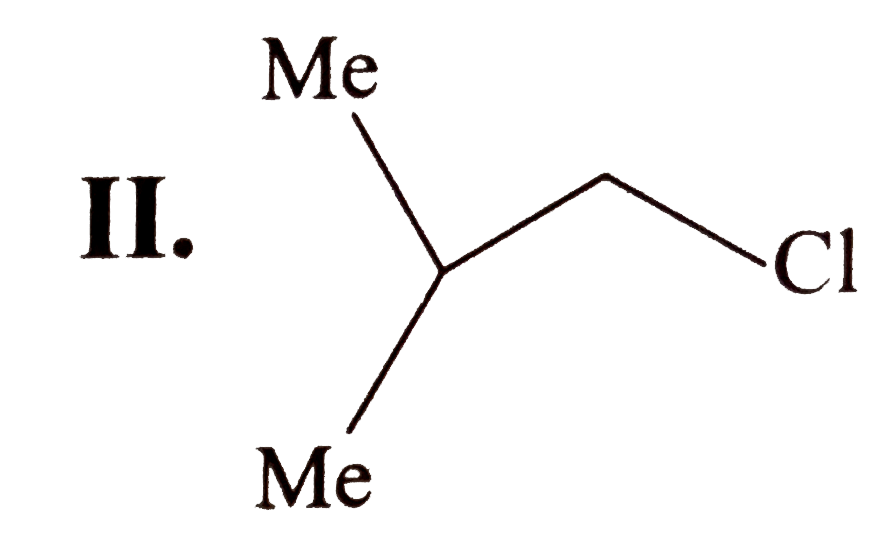
`III.` `IV.`
`IV.` 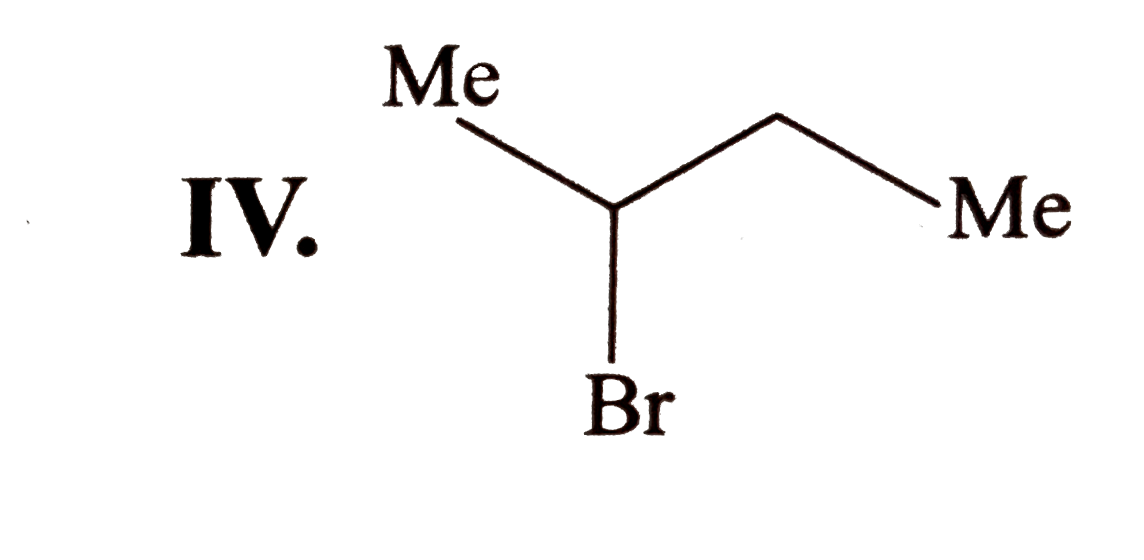
`V.`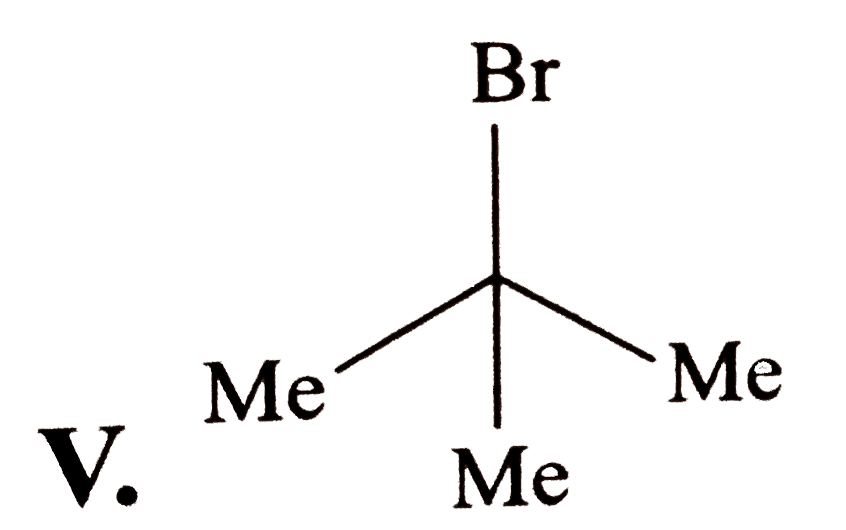
`b.` `I.`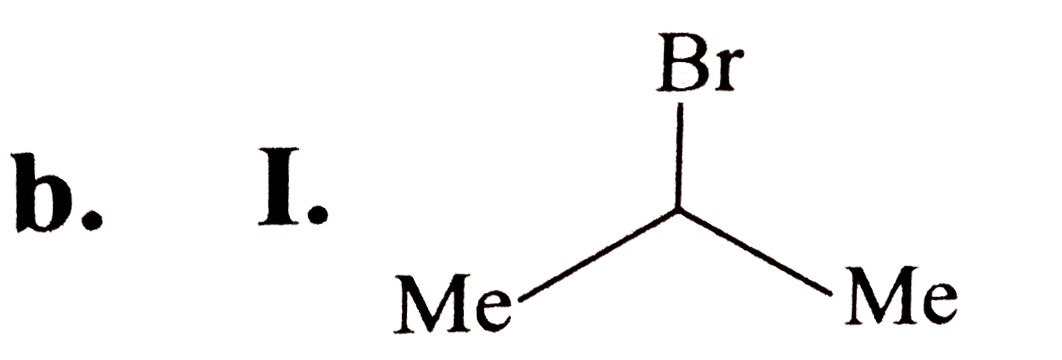 `II.`
`II.` 
`III.`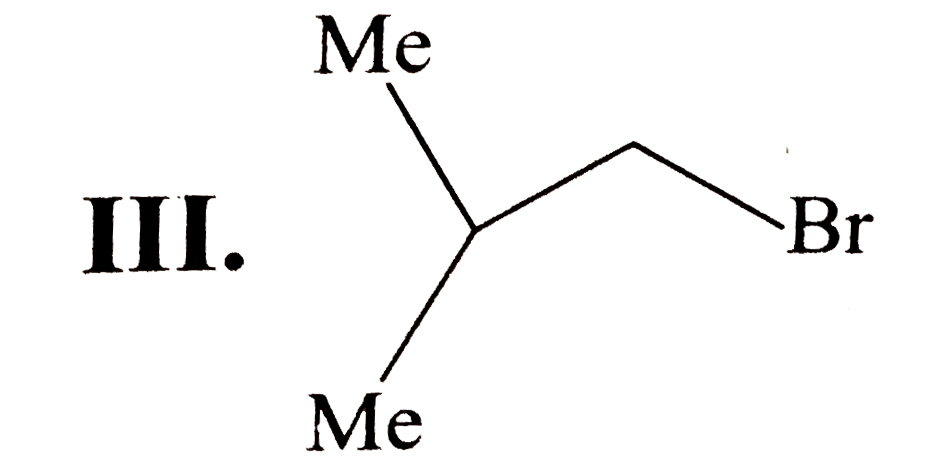 `IV.`
`IV.` 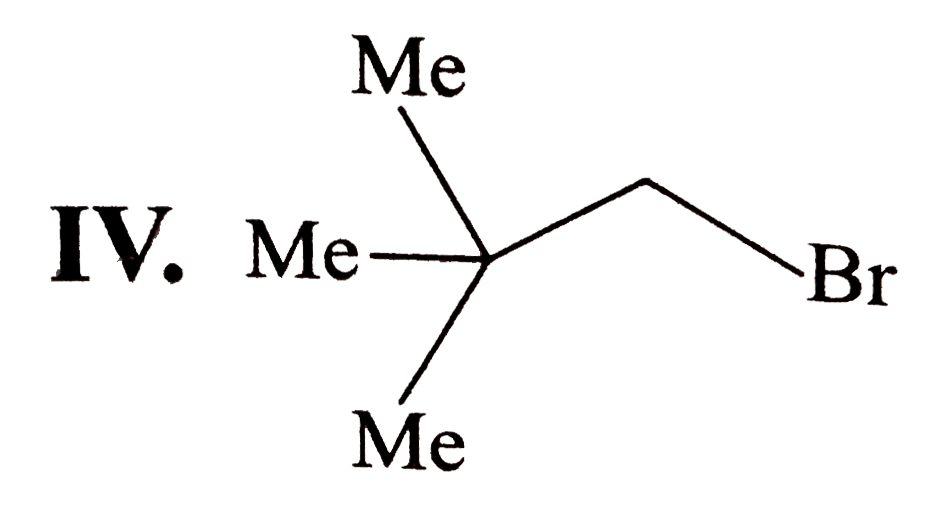
View SolutionGive the majore and minor products of the following reactions.
`a.`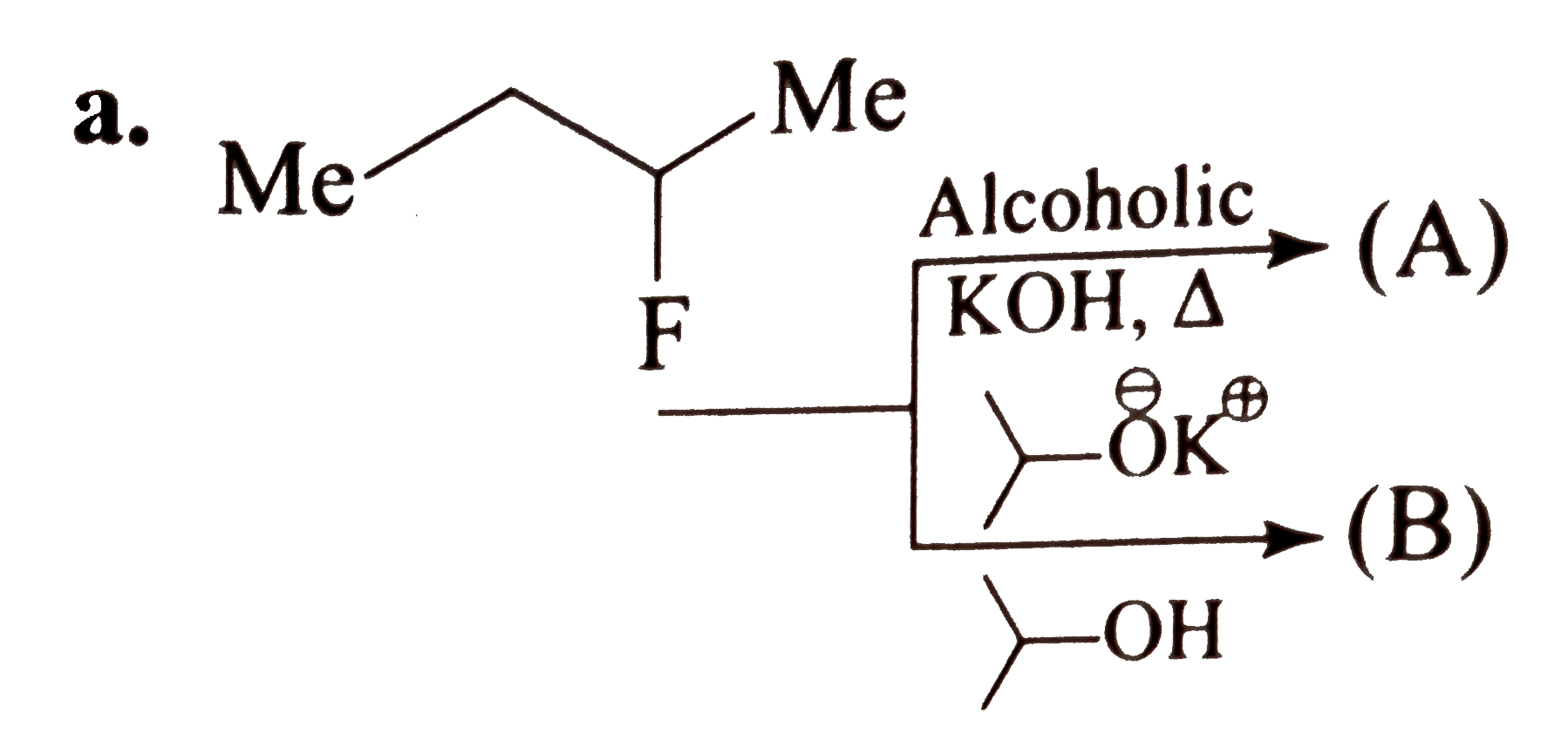
`b.`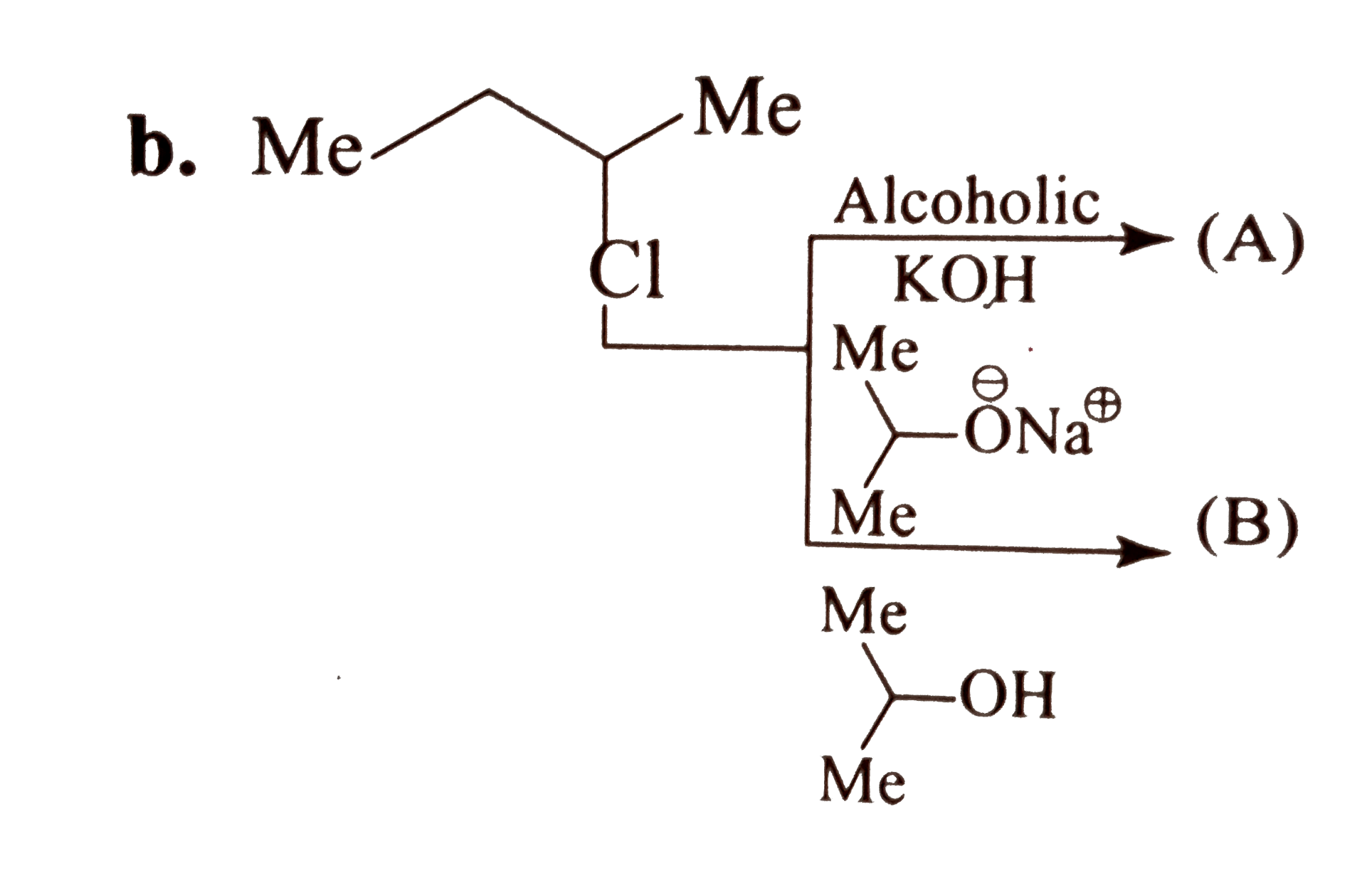
`c.`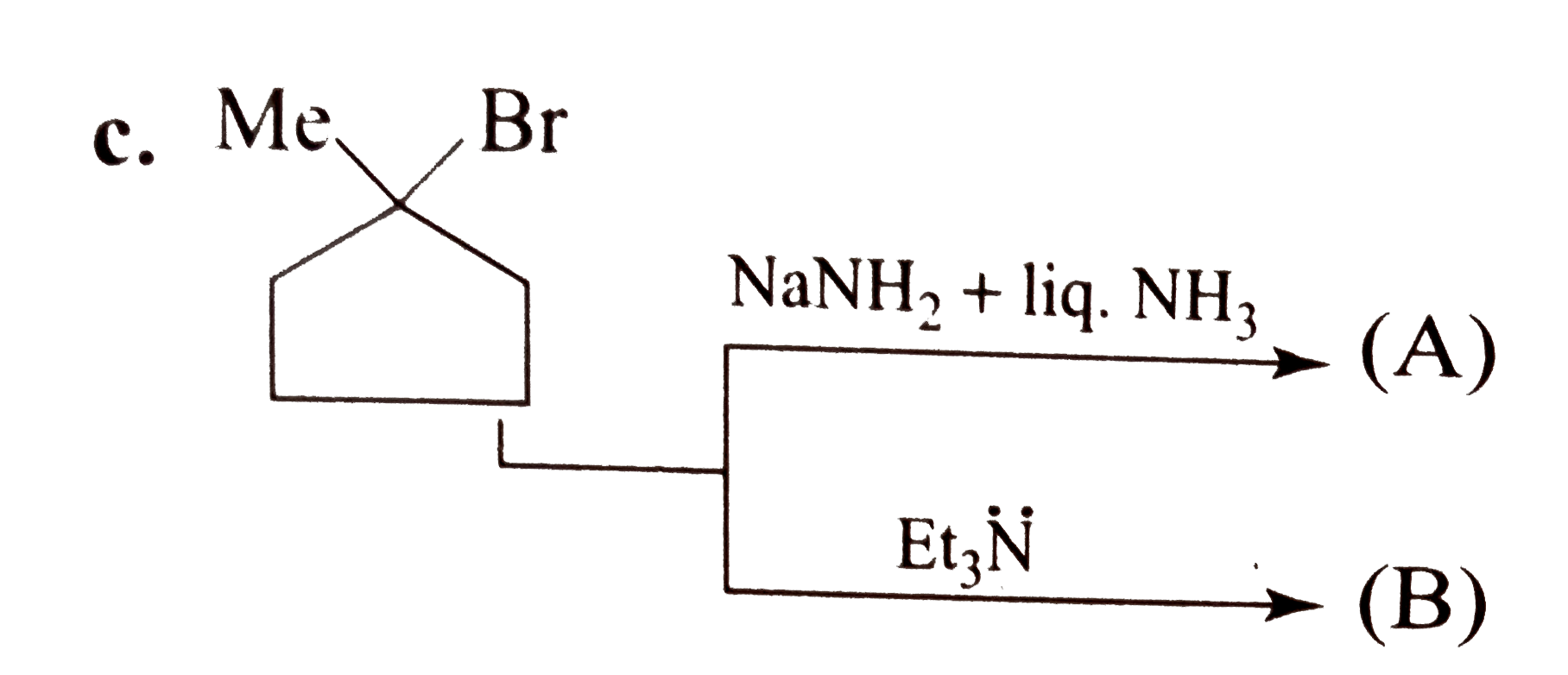
`d.`
`e.`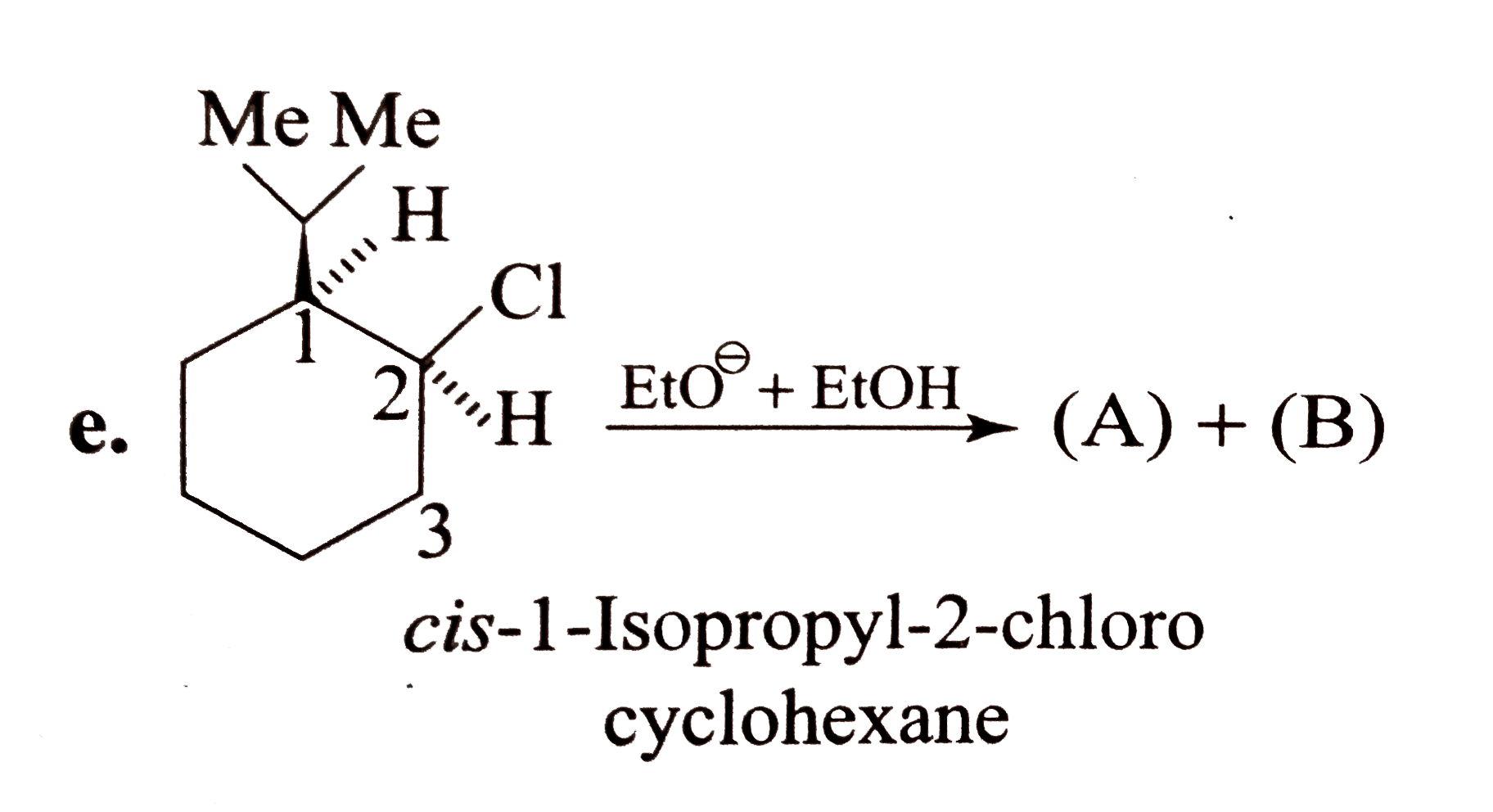
`f.`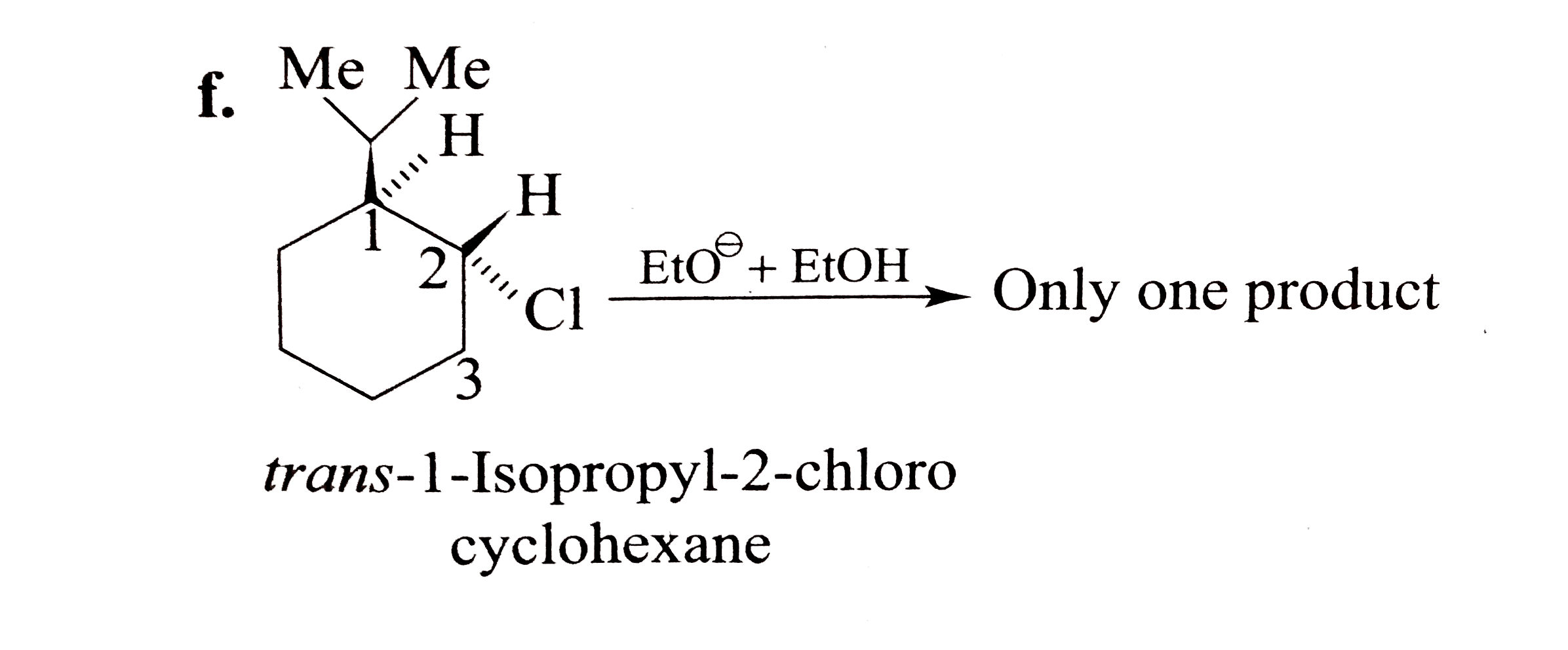
View SolutionExplain the stereochemistry of the products from `E2` dehalogenation with `I^(Θ)` of the following.
`a.` `(i)` Meso `-2-3-`dibromobutane and `(ii)` `S,S-2,3-` dibromo`-` butane.
`b.` `E2-` dehydrobromination of `(i)` `R,R-2,3-` dibromobutane and `(ii)` meso`-(R,S)-2,3-` debromobutane
`c.` From which conformation of bromocyclohexane in the `E2` dehydrobromination is best achieved.
View SolutionExplain that `(A)` readily forms an alkene with `I^(c-)` but `(B)` does not.
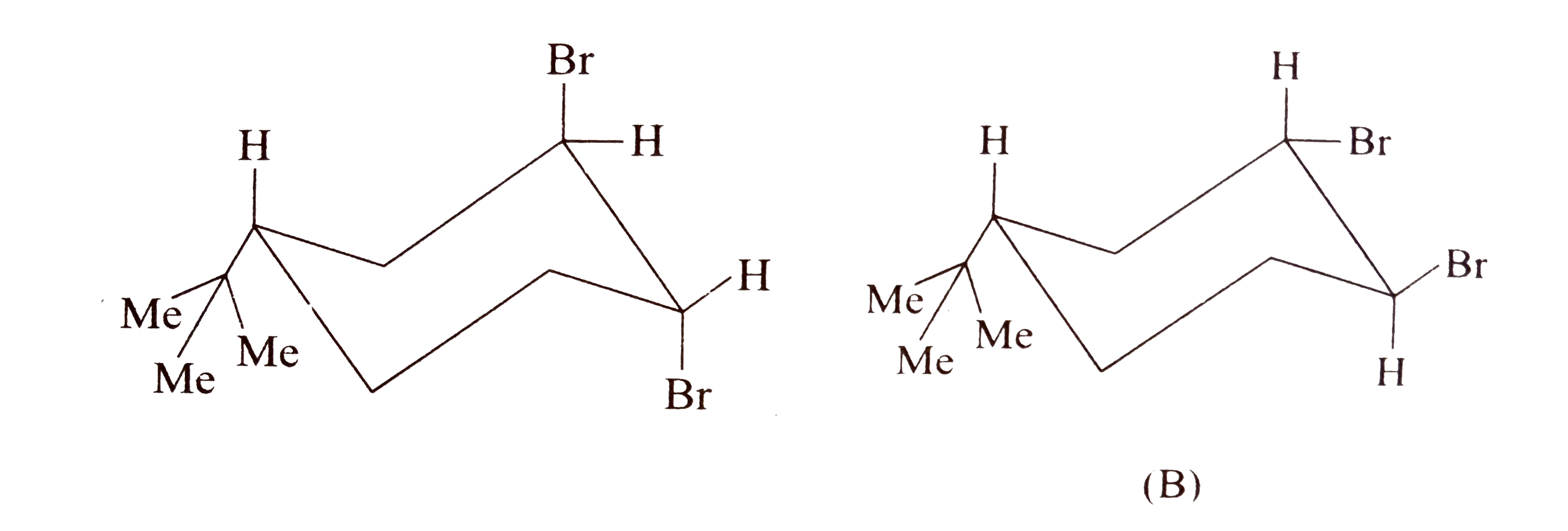
View SolutionExplain
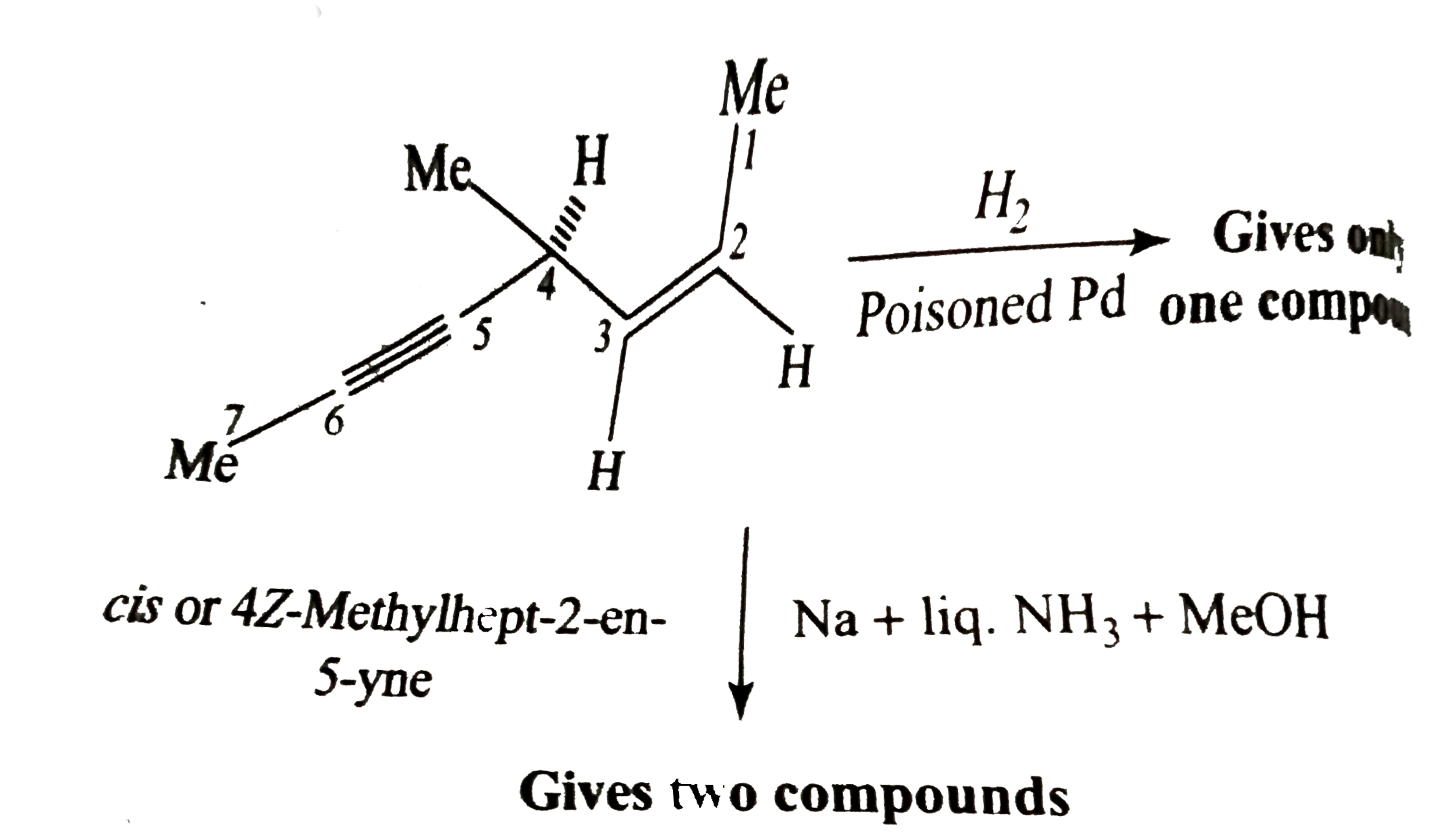
Gives two compounds.
View SolutionIdentify `A` and `B`.
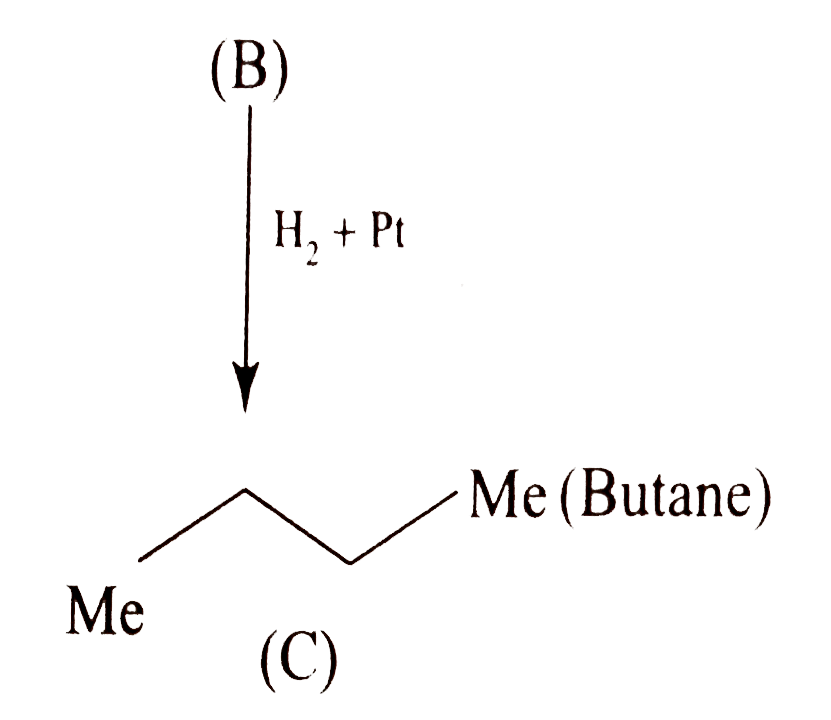
Gas `(B)` gives test for unsaturation, `i.e.,` it decolourises `Br_(2)` water and aqueous `KMnO_(4)` solution.
View Solution`i.` Predict the more stable alkene of each pair.
`ii.` For which pairs could you use `DeltaH_(h)^(@)?`
`iii.` For which pairs could you use `DeltaH_(C)^(@)` to determine their relative stabilities ?
`I.` `a.` `2-` Methyl`-` pent `-2-` ene
`b.` `2,3-`Dimethyl`-` but`-2-`ene`DeltaH_(C)^(@)`
`II.` `c.` Hexane `d.` cis`-` Hex`-3-`ene
`III. e.` trans`-` Hex`-2-`ene `f.` `2-`Methyl`-` pent`-2-`ene
`IV.g.` cis`-` Hex `-3-`ene `b.` trans `-` Hex`-3-` ene
View SolutionGive the products with their stereoisomers, if any.
`a.`
`b.`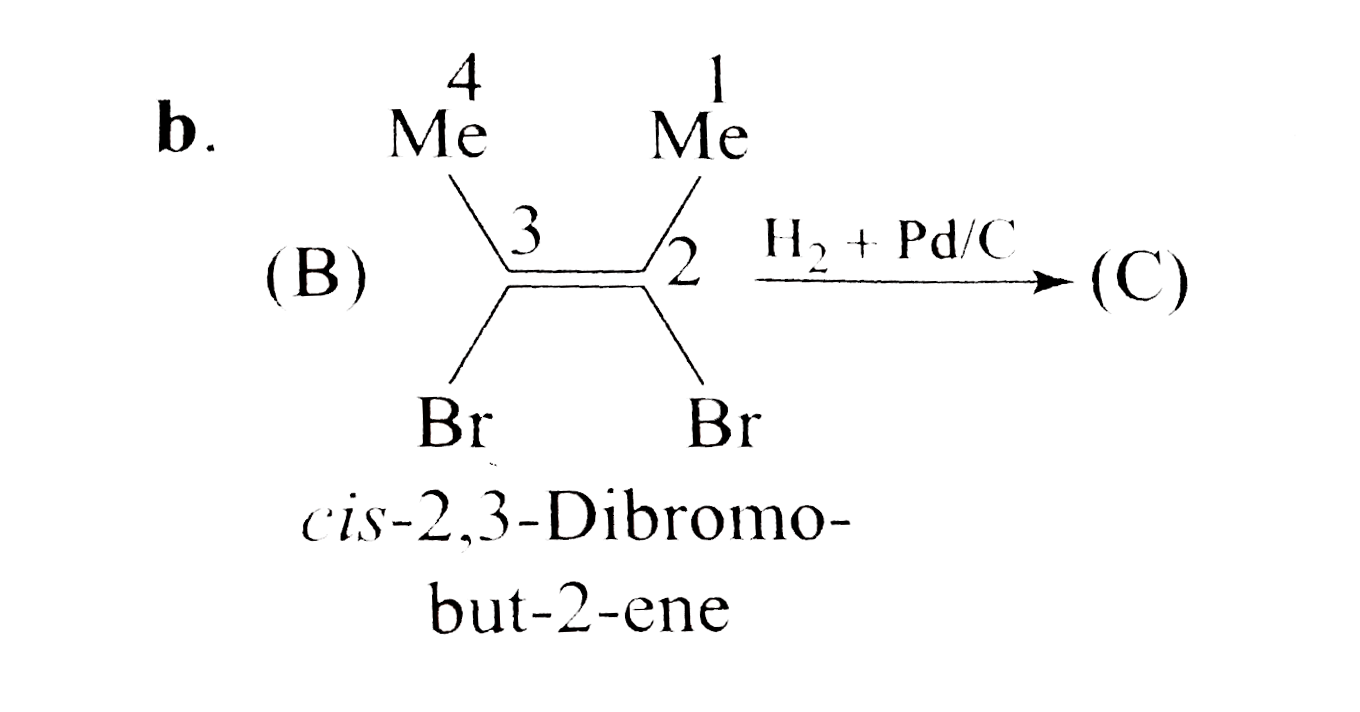 cis `-2,-` Dibromobut`-2-`ene
cis `-2,-` Dibromobut`-2-`ene
`c.`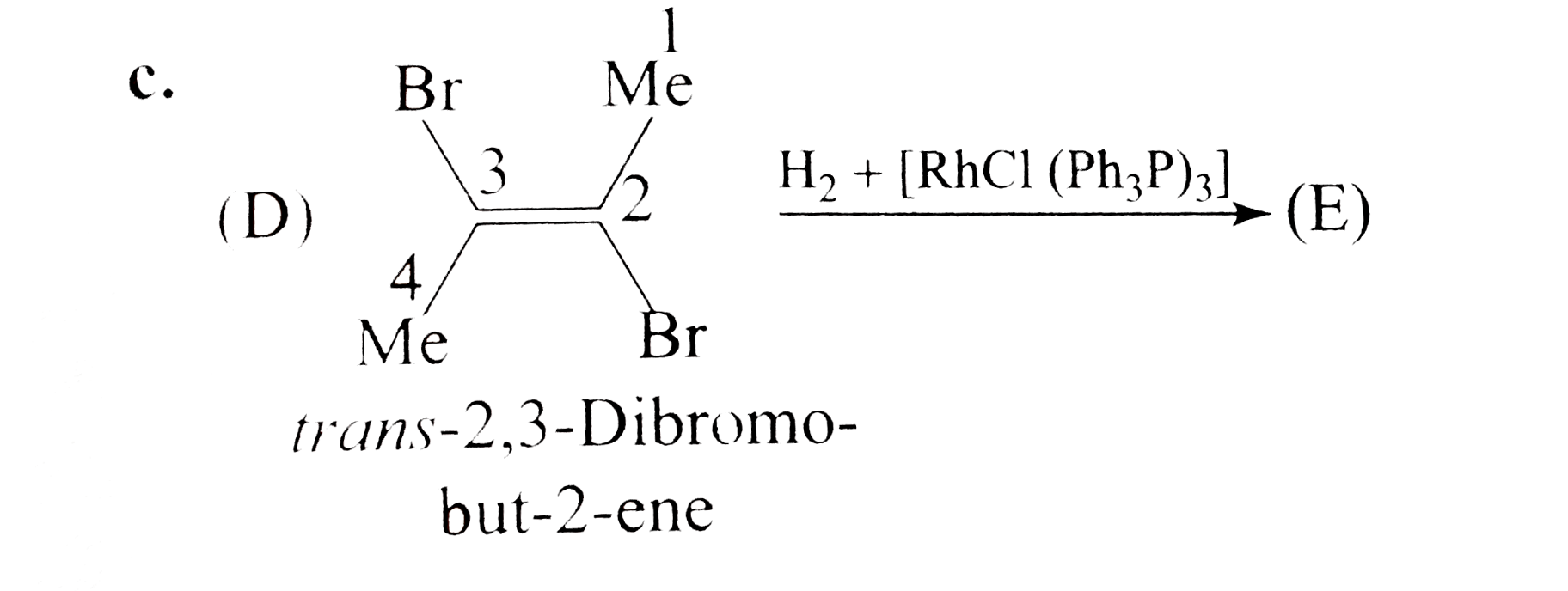 trans`-2,3-` Dibromobut`-2-`ene
trans`-2,3-` Dibromobut`-2-`ene
`d.`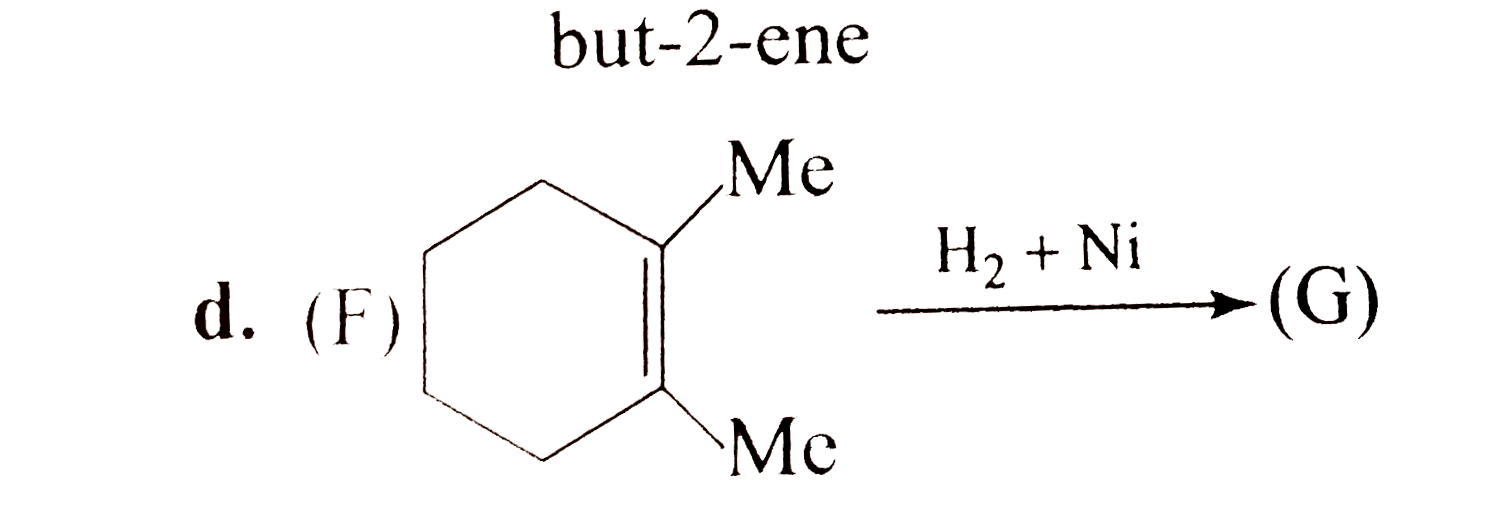
e. `underset("pent-2-ene")((H)"trans-2,3-Dibromo-")overset(H_(2)+PtO_(2))rarr(I)`
f.`underset("pent-2-ene")((J)"cis-2,3-Dibromo-")overset(H_(2)+Pt+C)rarr(K)`
g. cis - But -2-ene `overset(D_(2)+Pt)rarr`
`h.` trans`-` But `-2-` ene `overset(D_(2)+Pd)rarr`
`i.` Why is the stereochemical product same when cis `-` or tans `-` pent `-2-` ene is hydrogenated with `D_(2)`, in the presence of platinum ?
`j. `Classify the two reactions `: (i)` hydrogenenation of alkene with transition metala `(Pt` or `Pd` or `Ni)` and `(ii)` hydrogenation with Wilkinson's catalyst in terms of catalyst used and their mechanism of hydrogenation with Wilkinson's catalyst.
View SolutionComplete the following with stereo`-` chemistry.
`a.`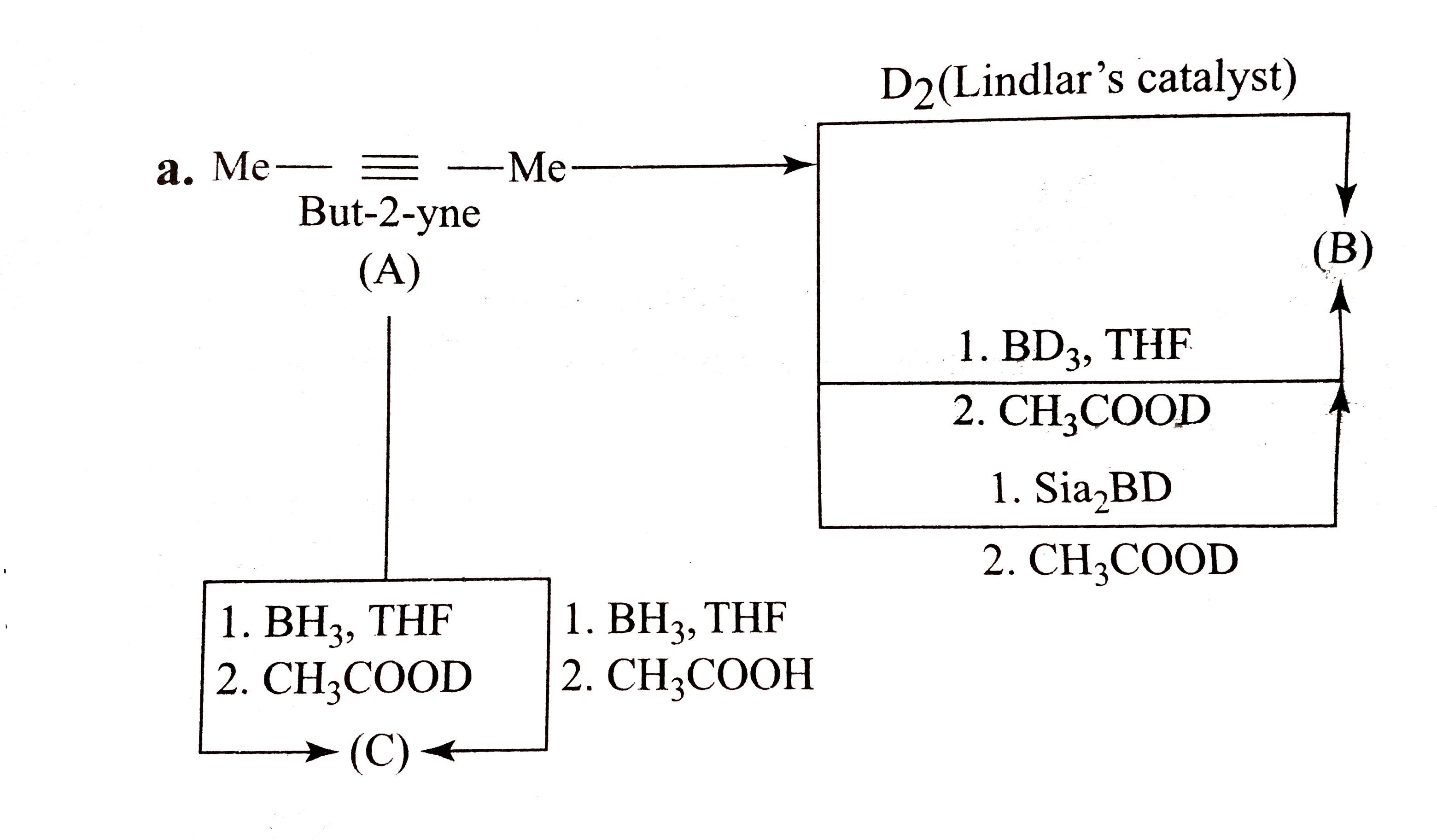
`b.`
`c.`
`d.`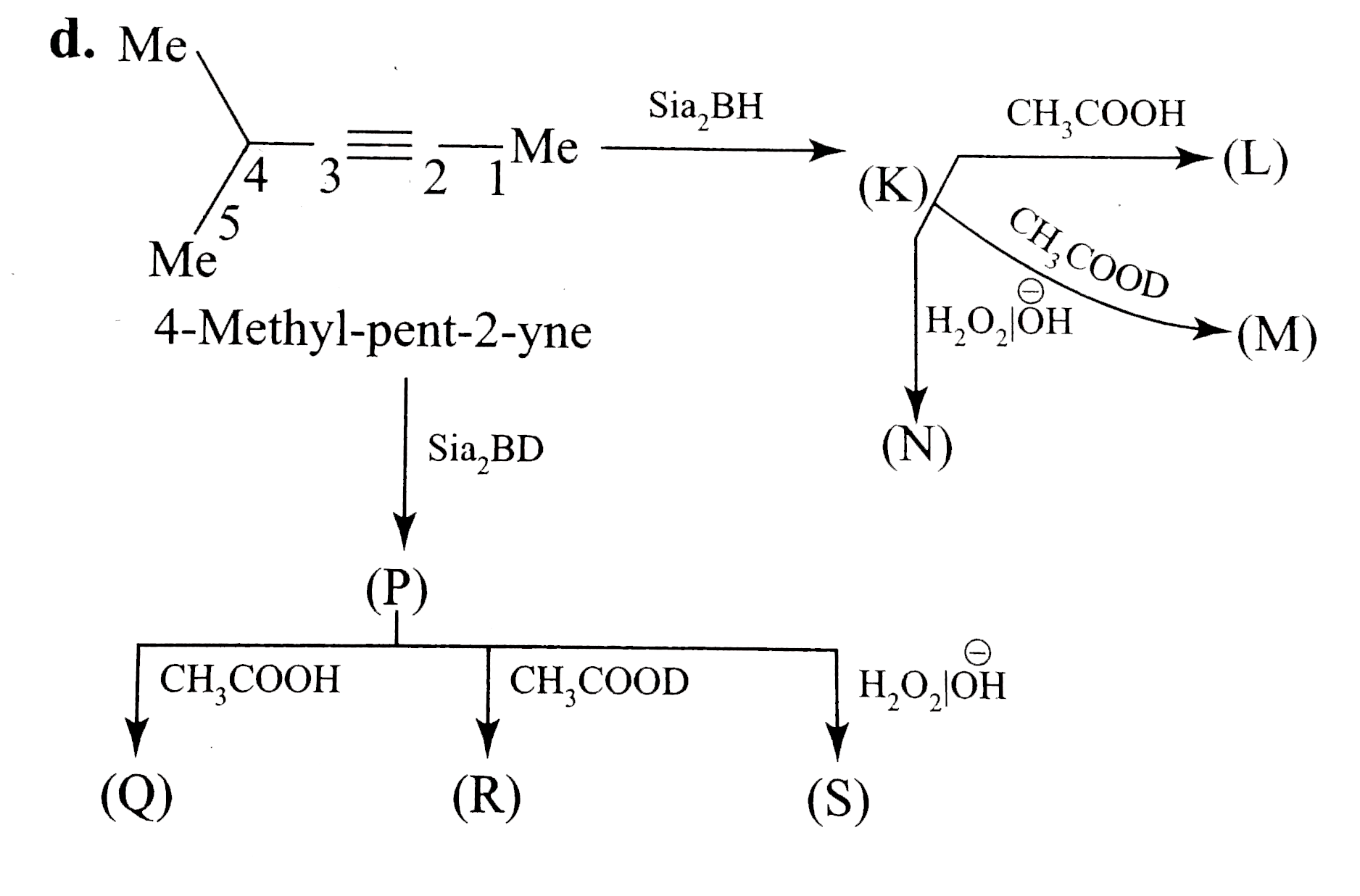
`e.`
View SolutionDesignate the type of each set of `H ` atomes in `6-` methyl `-` hept `-2-`ene and list them in the decreasing order of reactivity towards radical substitution.
View SolutionComplete the following reaction `:`

View SolutionGive the products of the reactions given below.
`a.`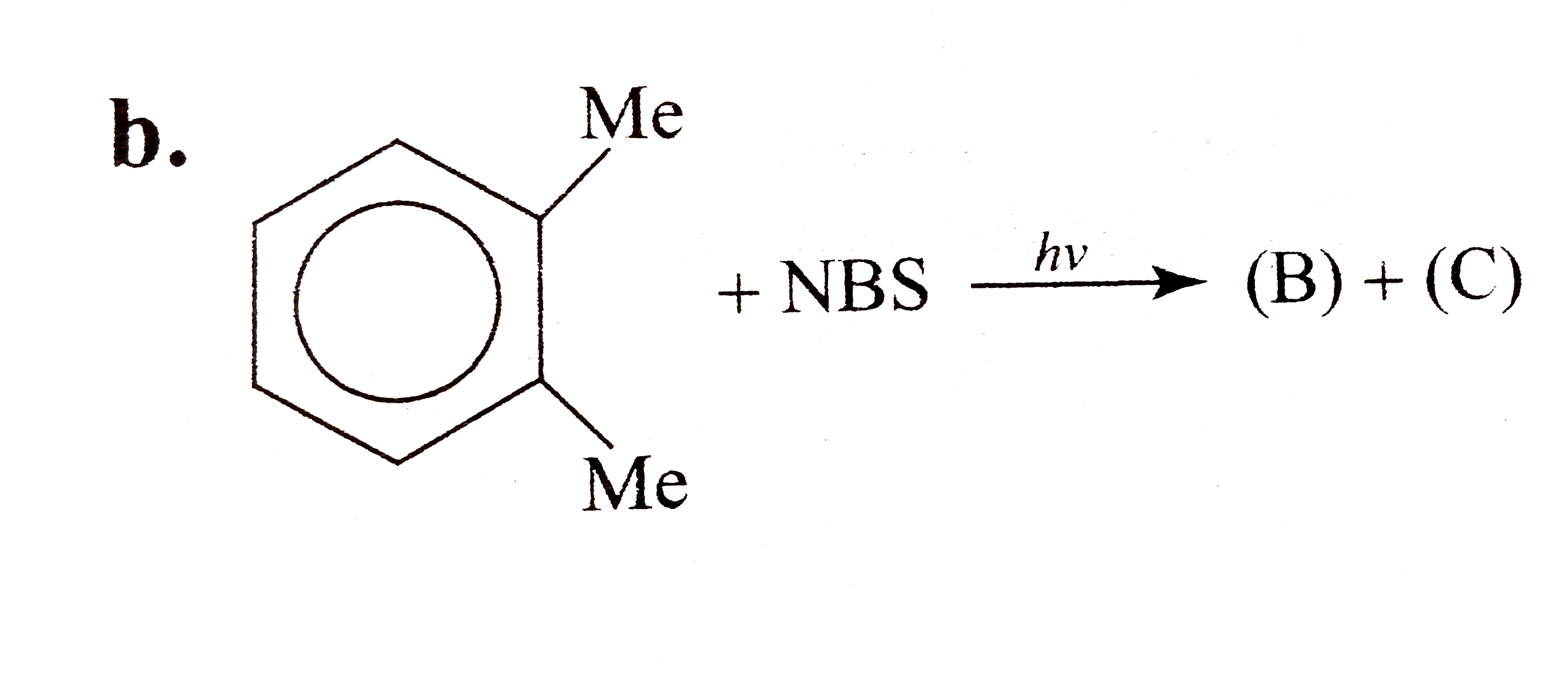
`b.`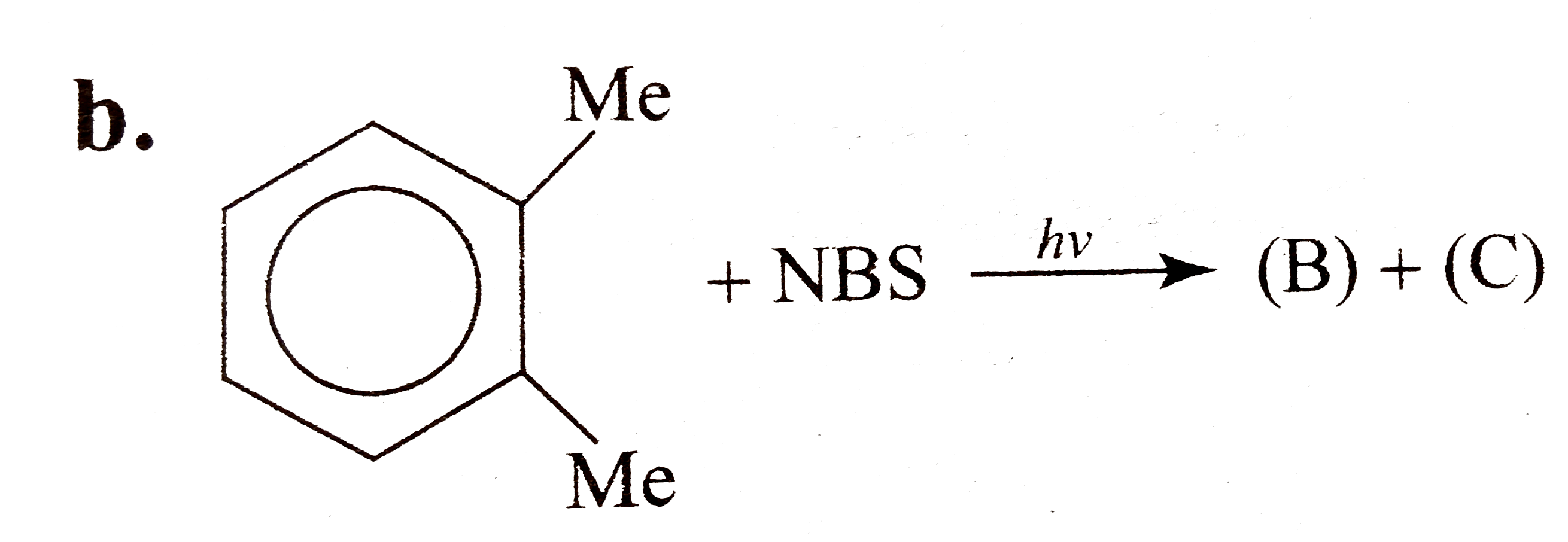
`c.`
`d.`
`e.`
`f.`
`g.` Three products
Three products
View SolutionComplete the following reaction `:` `i.`

`ii.`
`iii.`
`iv.`
`v.`
`vi`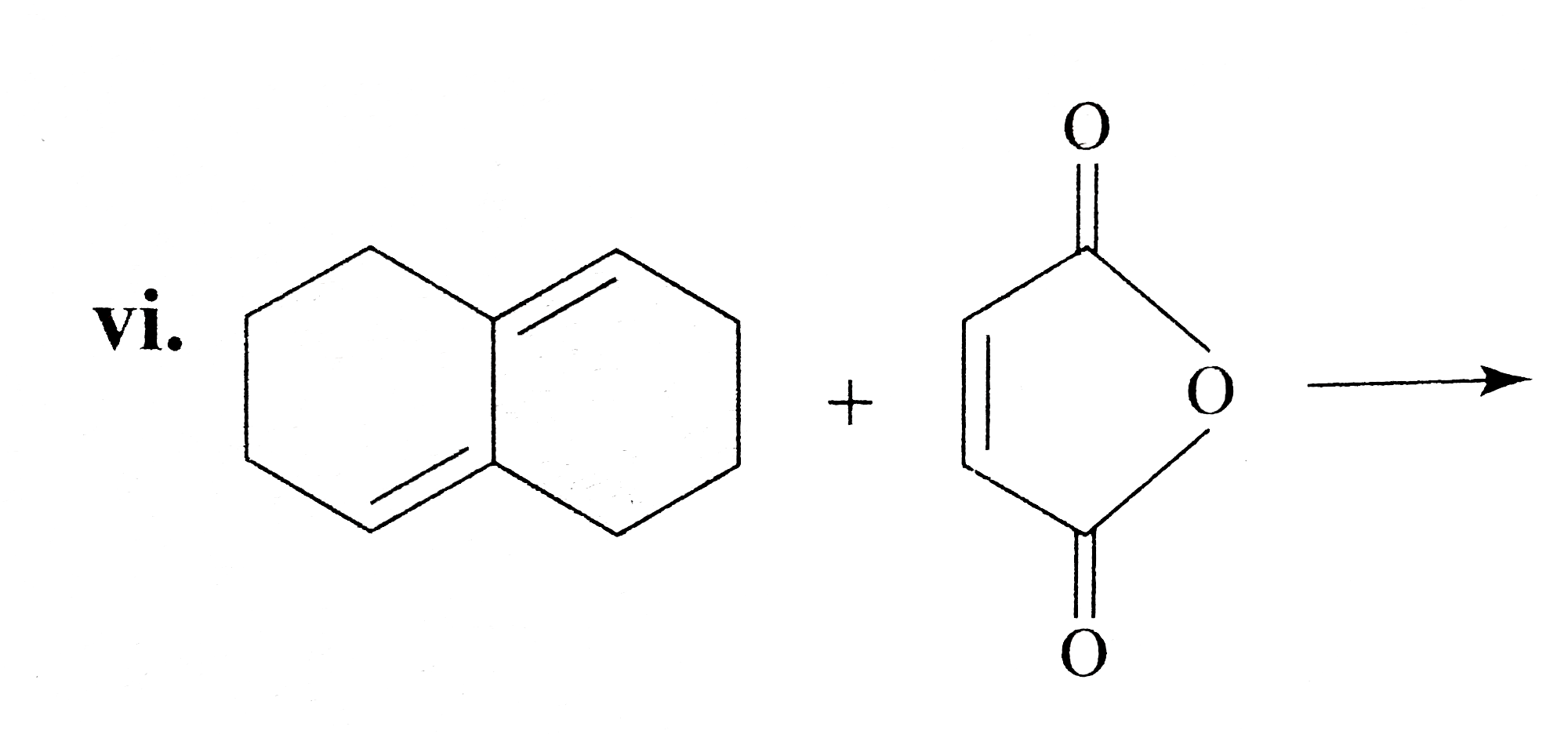
`vii.`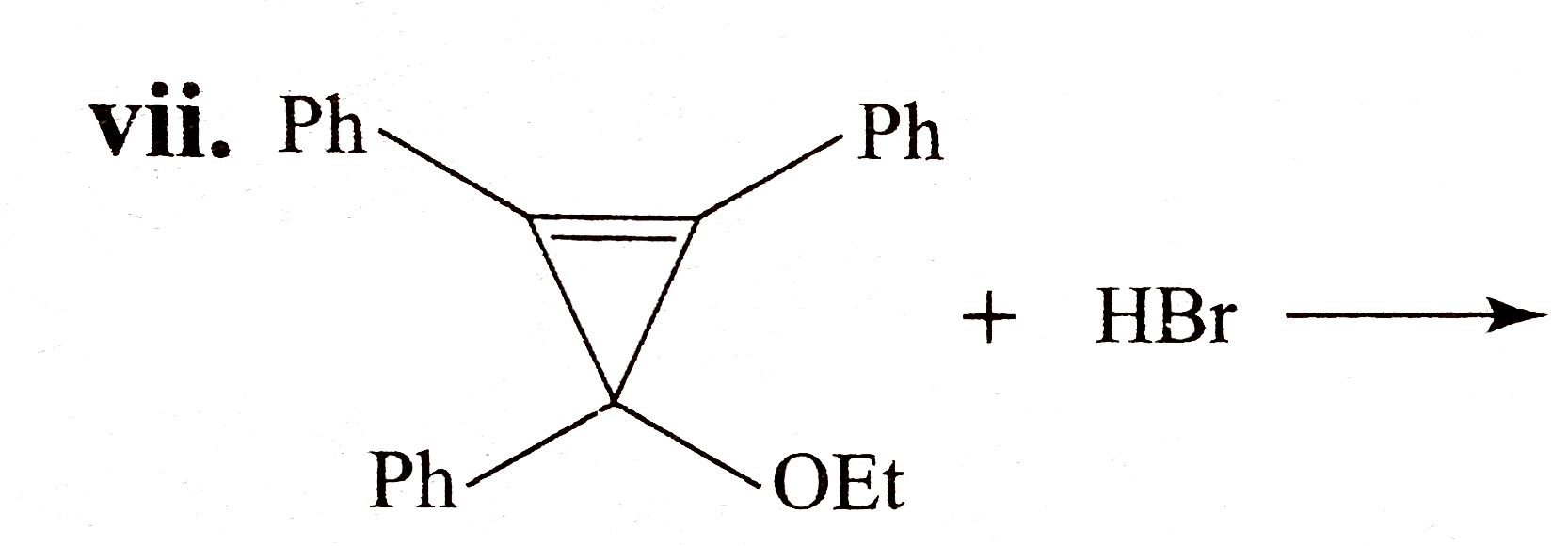
`viii`
`ix.`
`x.`
View SolutionComplete the following reactions `:`
`a.`
`b.`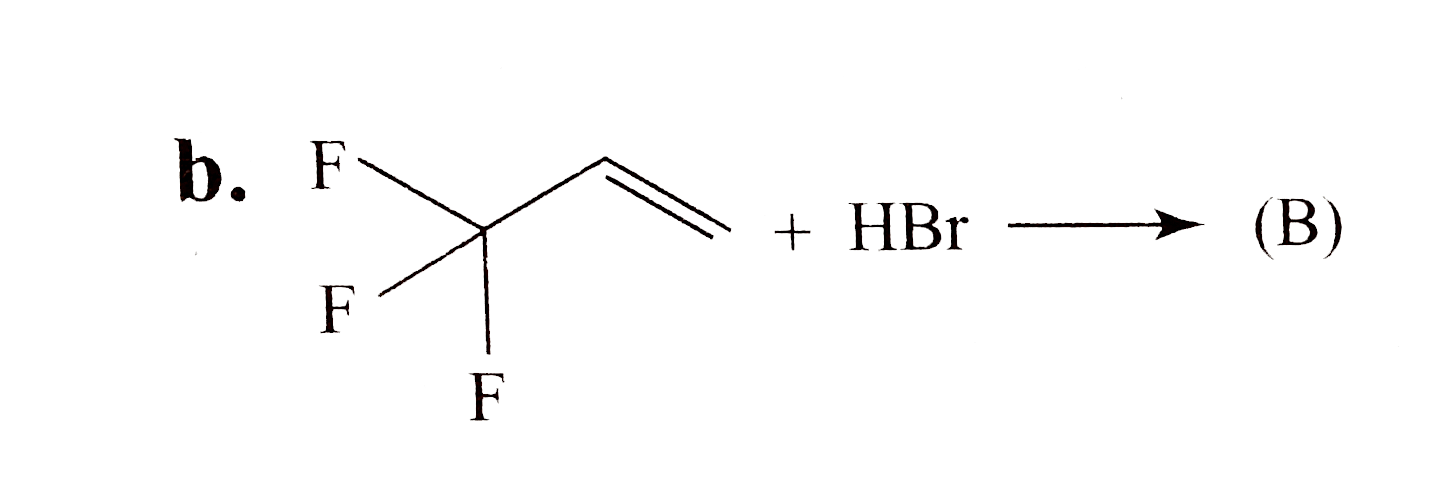
`c.`
`d.`
`e.`
`f.`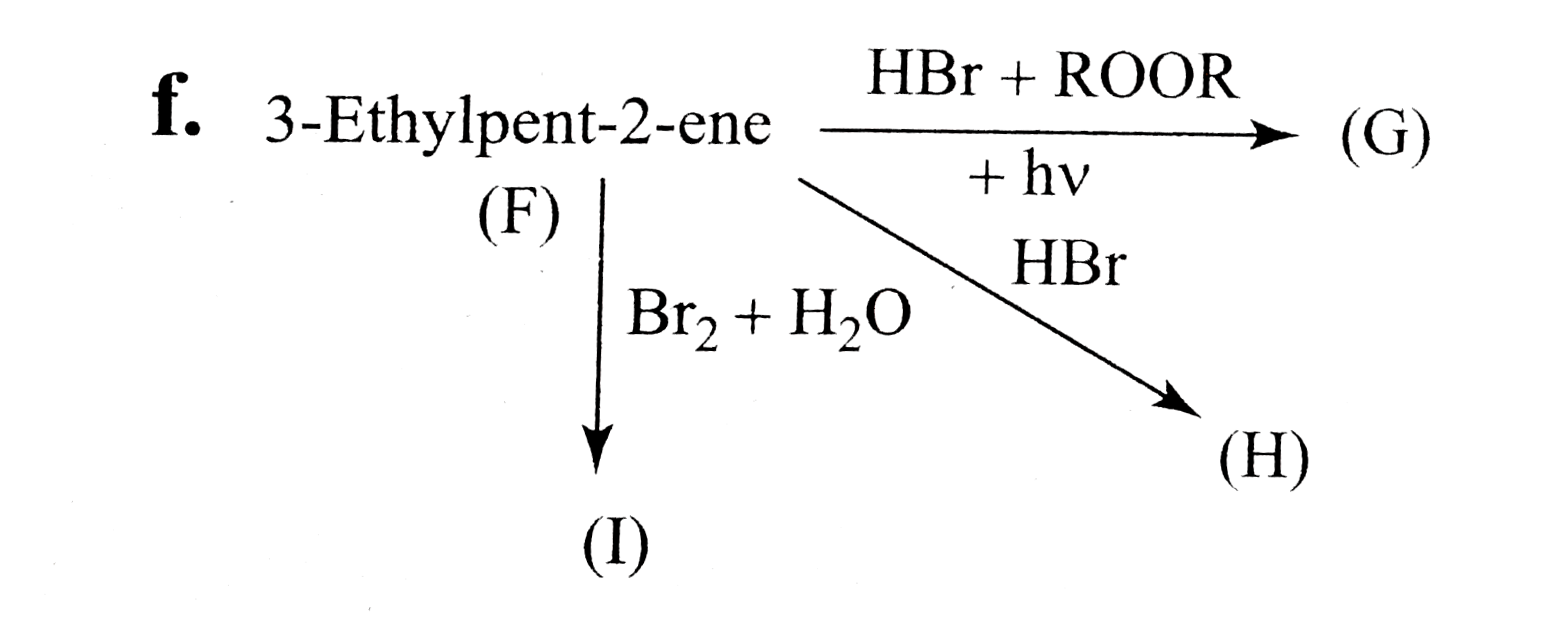
`g.`
`h.`
`i.` Alkenes like ethene dissolve in conec. `H_(2)SO_(4)` but alkynes like ethyne do not dissolve in cone. `H_(2)SO_(4)`, whereas but `-2` yne dissolves. Explain.
`j.` Identify `X,Y `and `Z`

`k.`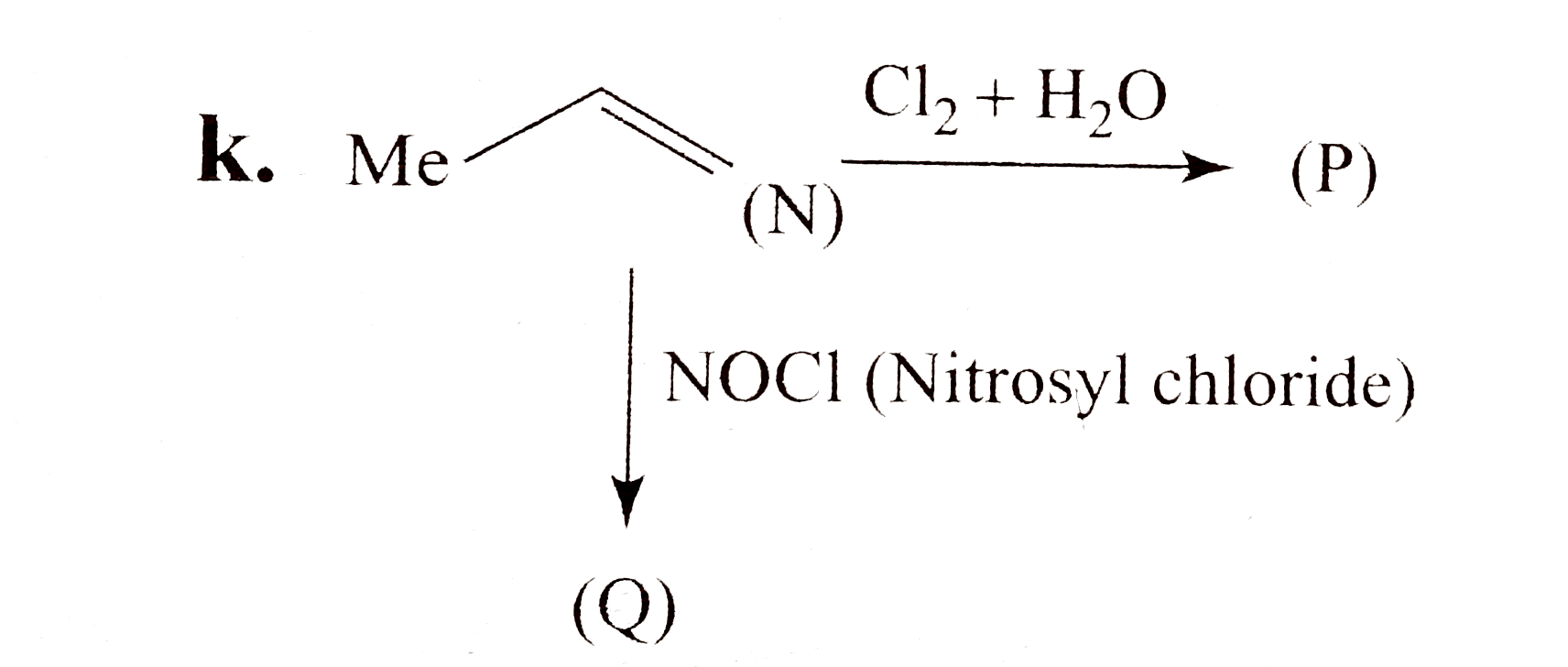
`l.` `2CH_(2)=CH_(2)+underset("mono-chloride")underset("Sulphur")(S_(2)Cl_(2))rarr(R )+underset("Sulphur")(S)`
`m.`
`n.`

View SolutionComplete the following reactions `:`
`a.`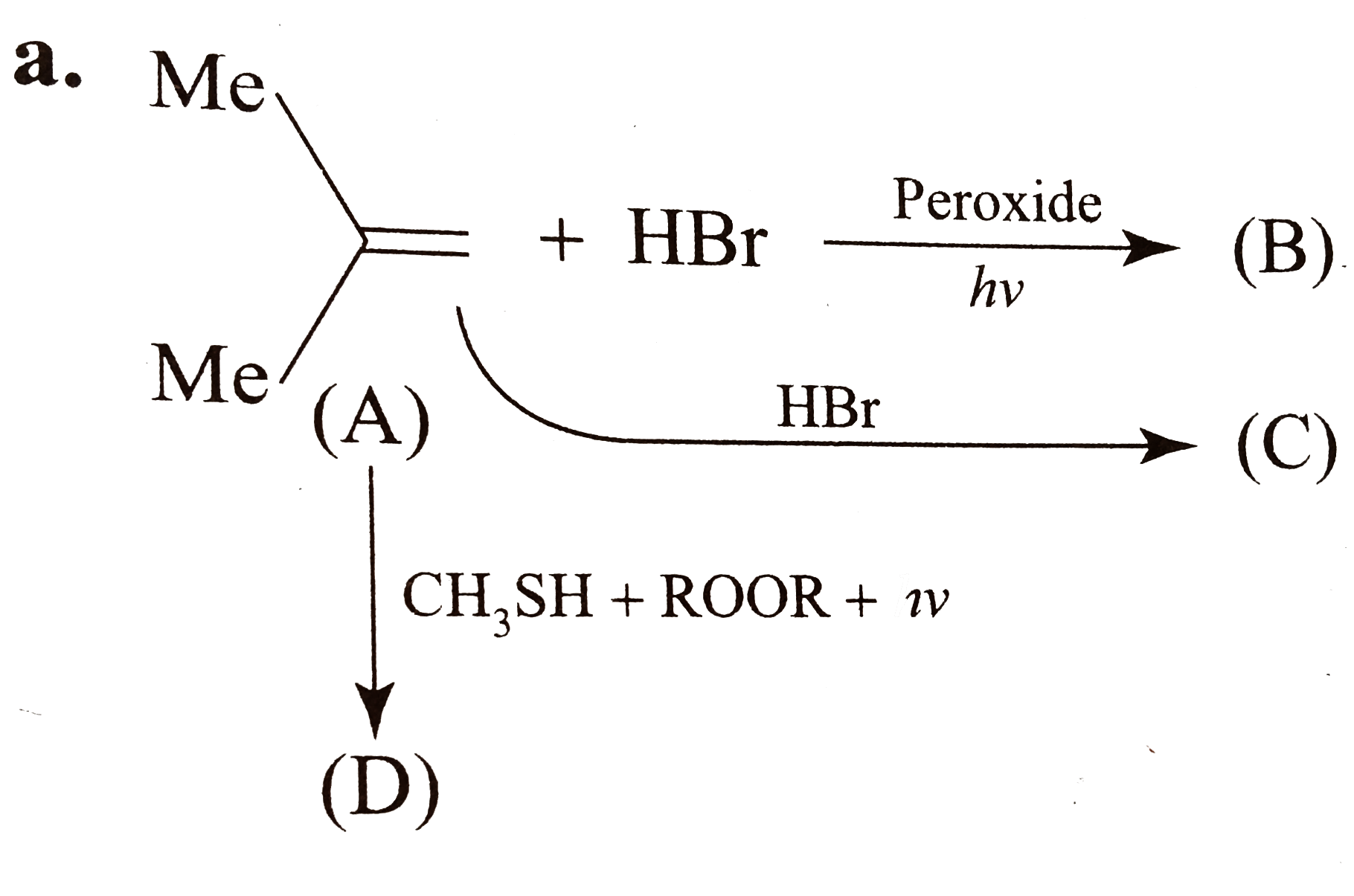
`b.`
`c.`
`d.`
`e.`
View SolutionGive the sterochemical products of the following `:`
`a.`
`b.`
`c.`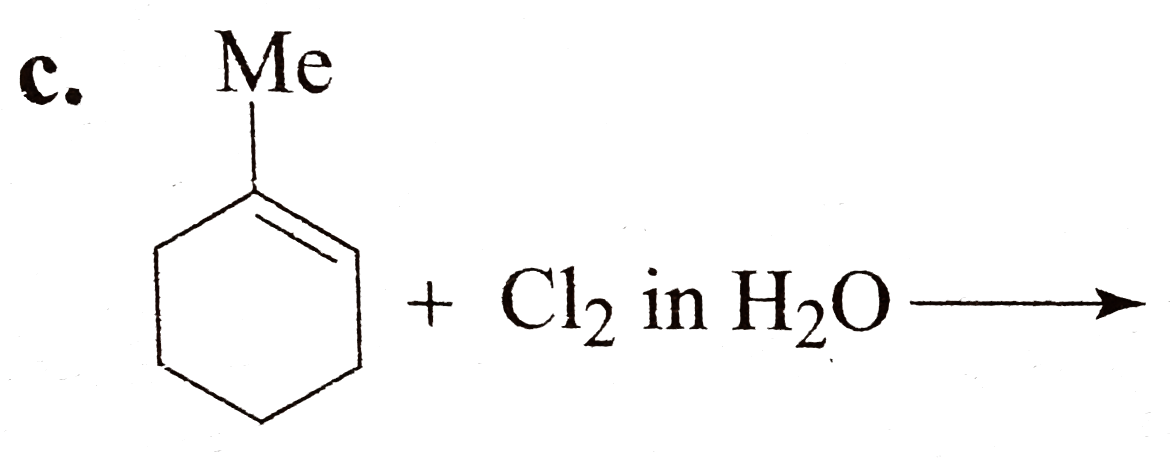
`d.`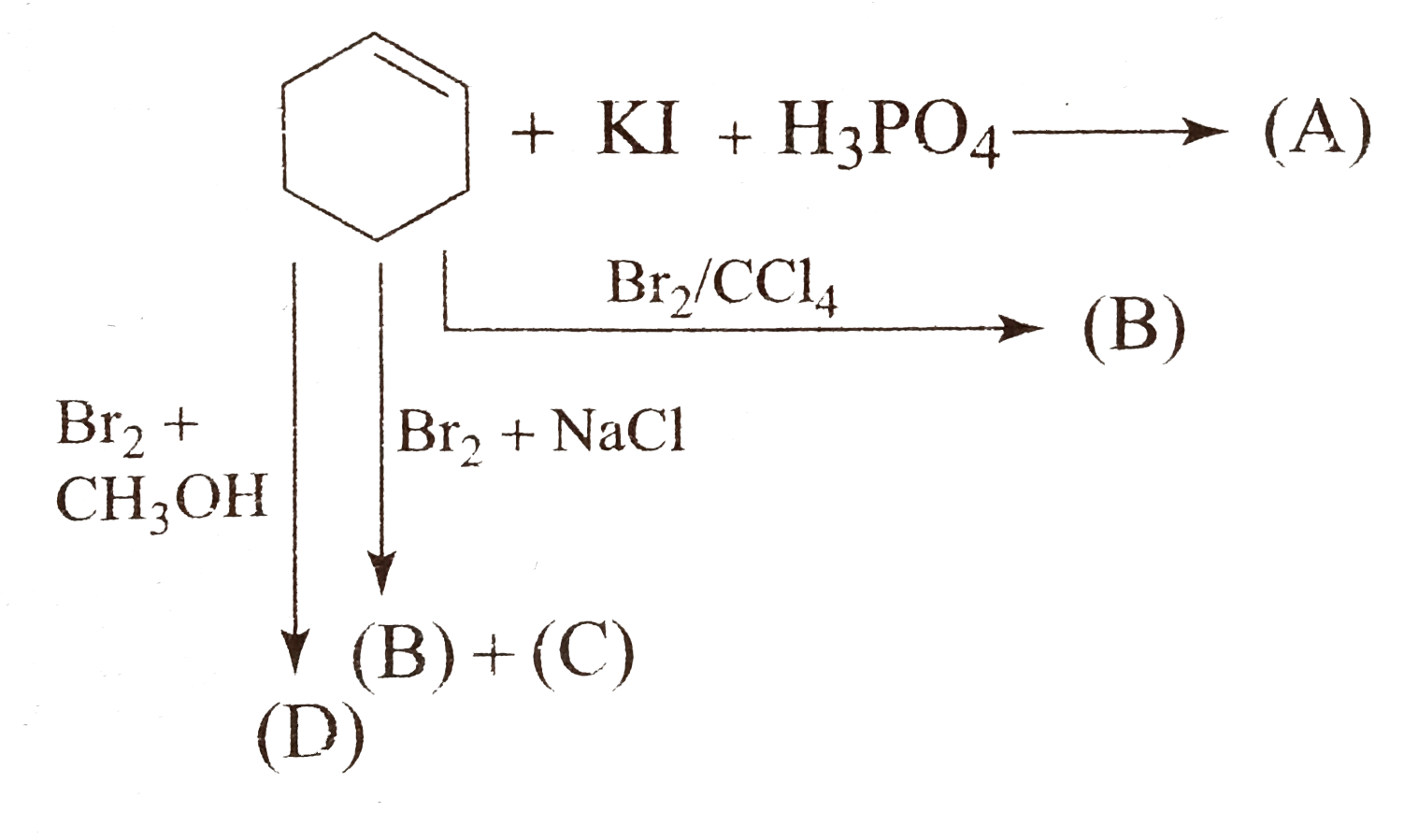
View SolutionComplete the following reaction `:`

View Solution
Give the major and minor products.
View SolutionComplete the following `:`
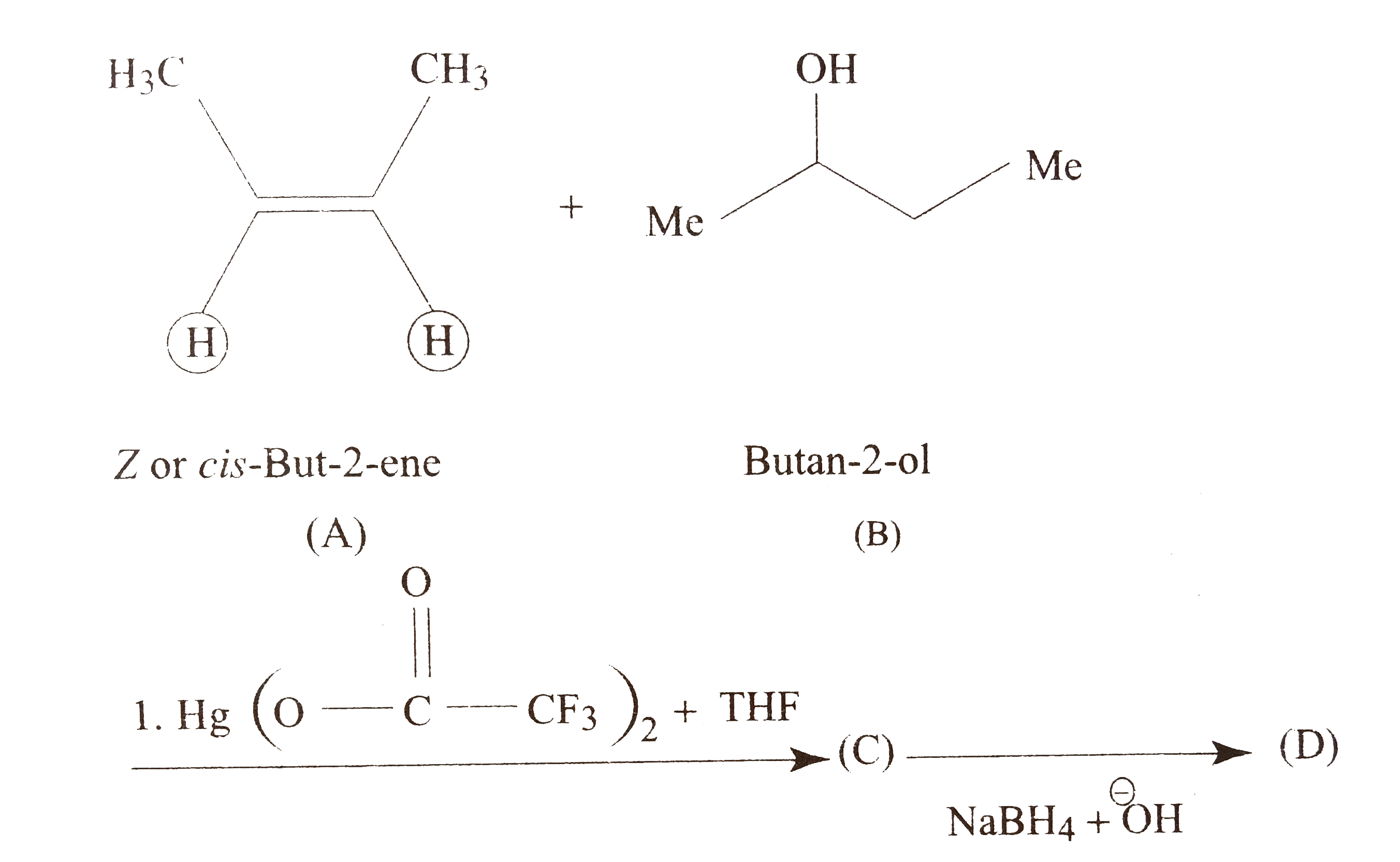
View SolutionComplete the following `:`
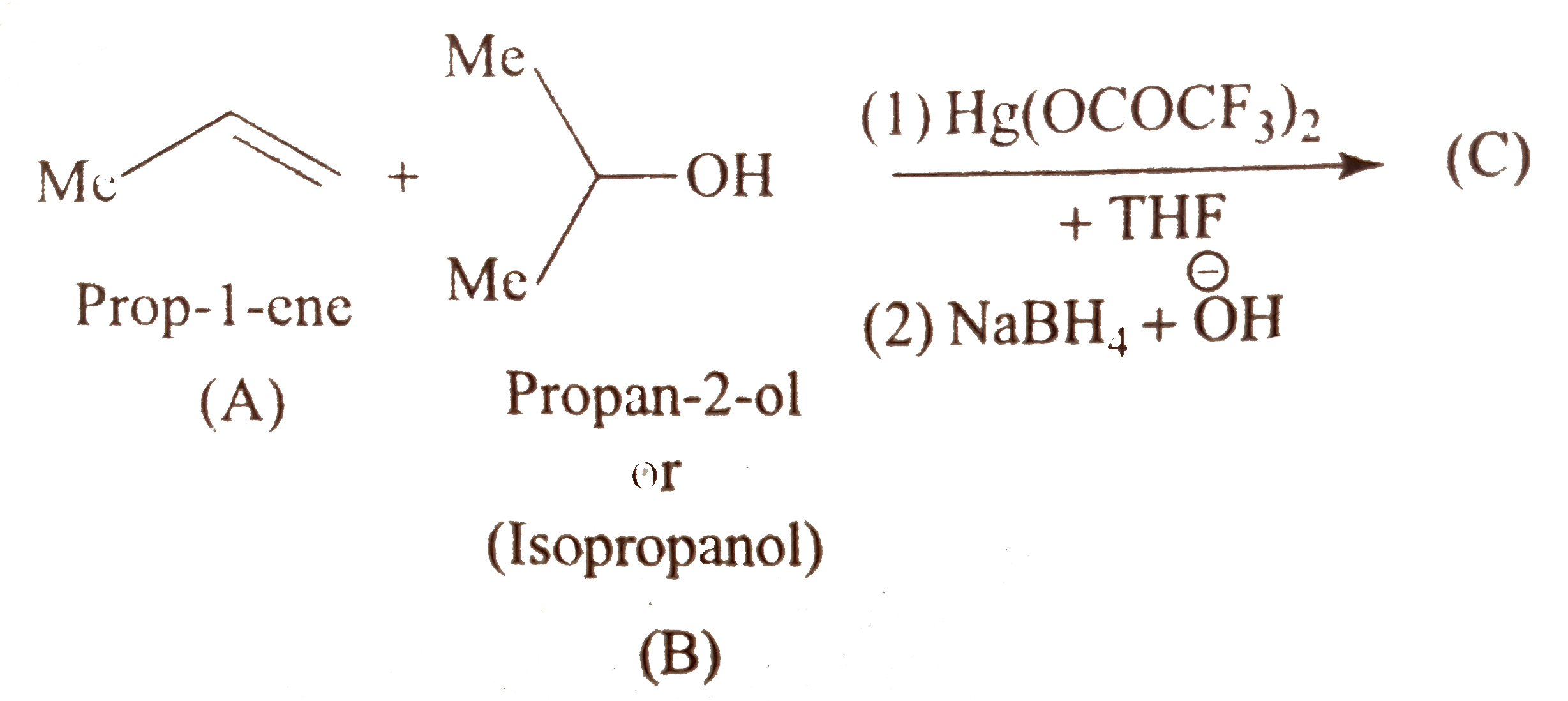 Propane
Propane
View SolutionIdentify (A), (B) and (C ).
`underset((C_(5)H_(10)))underset("Isomeric alkene")((A),(B),(C),)overset(H_(2)+Pt)rarr`2-Methyl butane
(A) and (B) `overset("Oxymercuration")underset(underset((O.M.D.))("demercuration"))rarr` Same `3^(@)` alcohol
(B) and (C) `overset("Hydroboration")underset(underset((H.B.O.))("oxidation"))rarr` Different `1^(@)` alcohol
View SolutionComplet the following `:`

View SolutionComplete the following reactions `:`
`i.`
`ii.`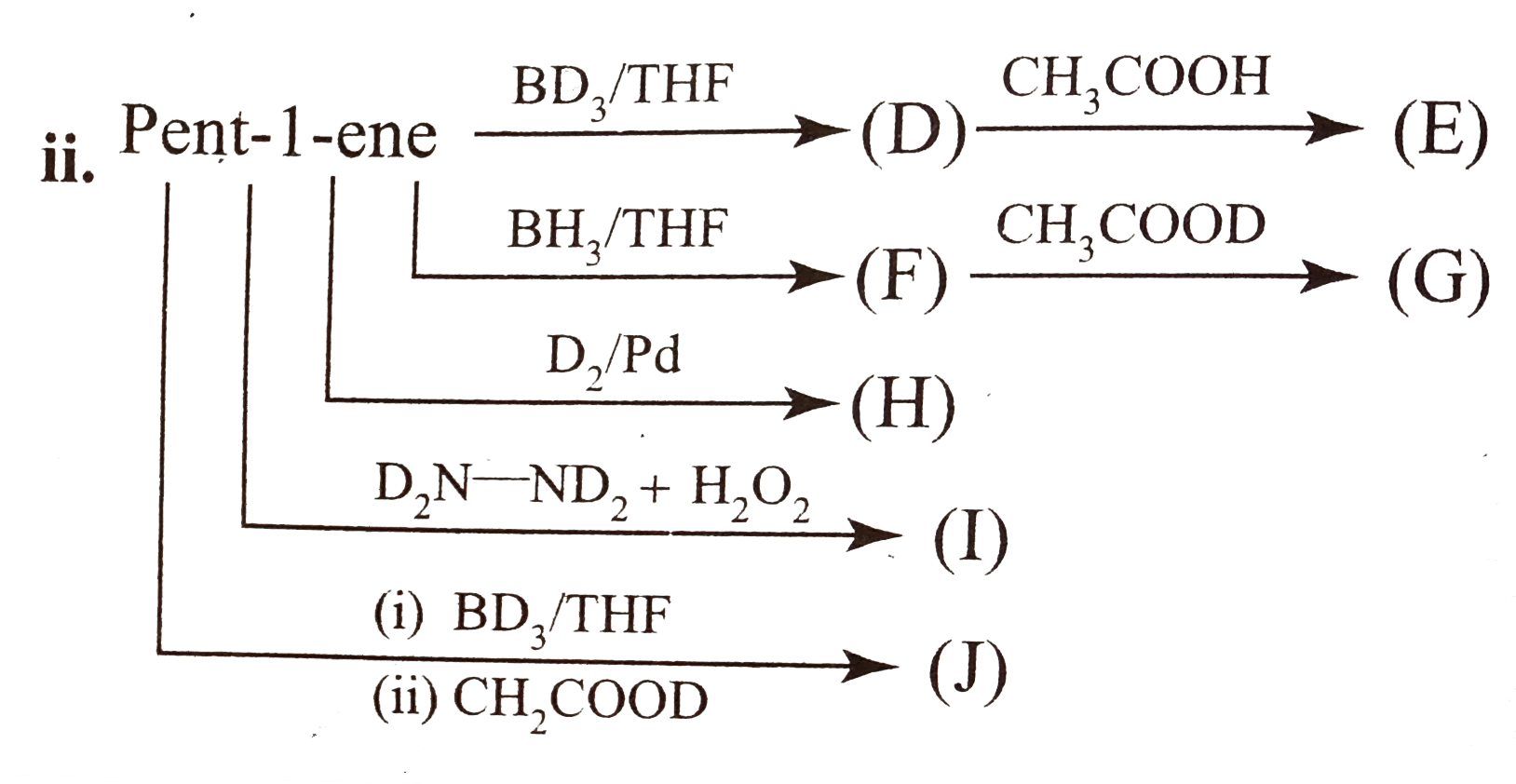
View SolutionComplete the following reactions `:`
`i.`
`ii.`
View SolutionGive the products of the following `:`
a. Cyclohexene `+CH_(2)N_(2)+hv`
b. trans `-2-` Butene `+CHCI_(3)+KOH`
c. cis -2- Butene`+HCBr_(2)CI+KOH`
d. trans -2- Butene`+HCBr_(2)CI+KOH`
e. 3-Methycyclopentene `+CH_(2)I_(2)+Zn//c u` (couple)
(Simmons `-` Smith reactions)
f.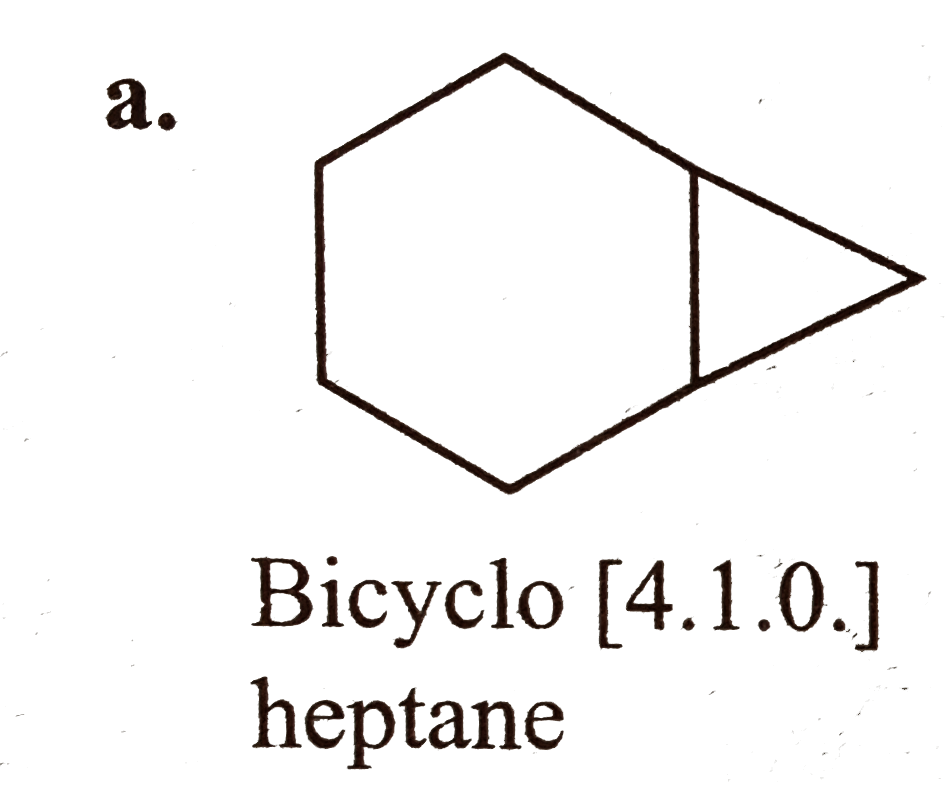
View SolutionComplete the following reactions `:`
a.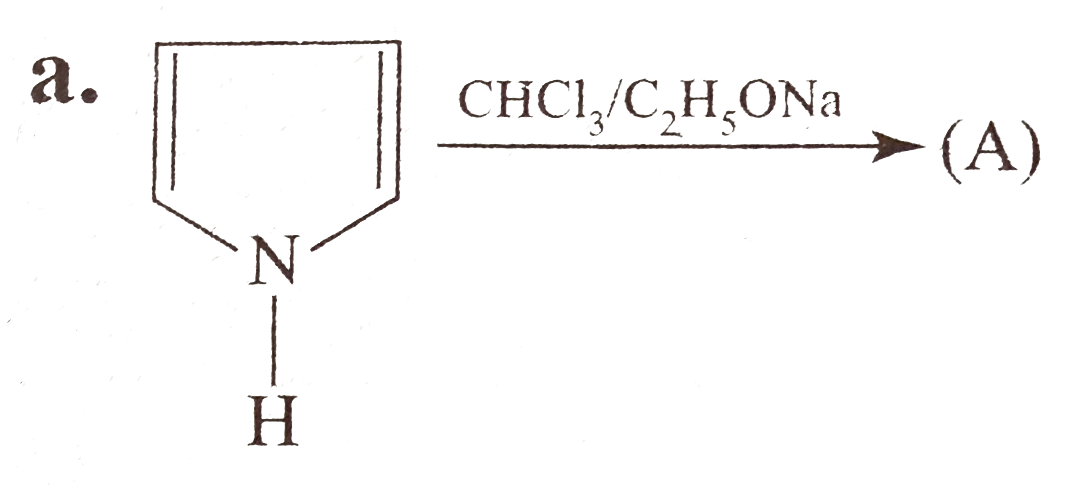 , b.
, b. 
c.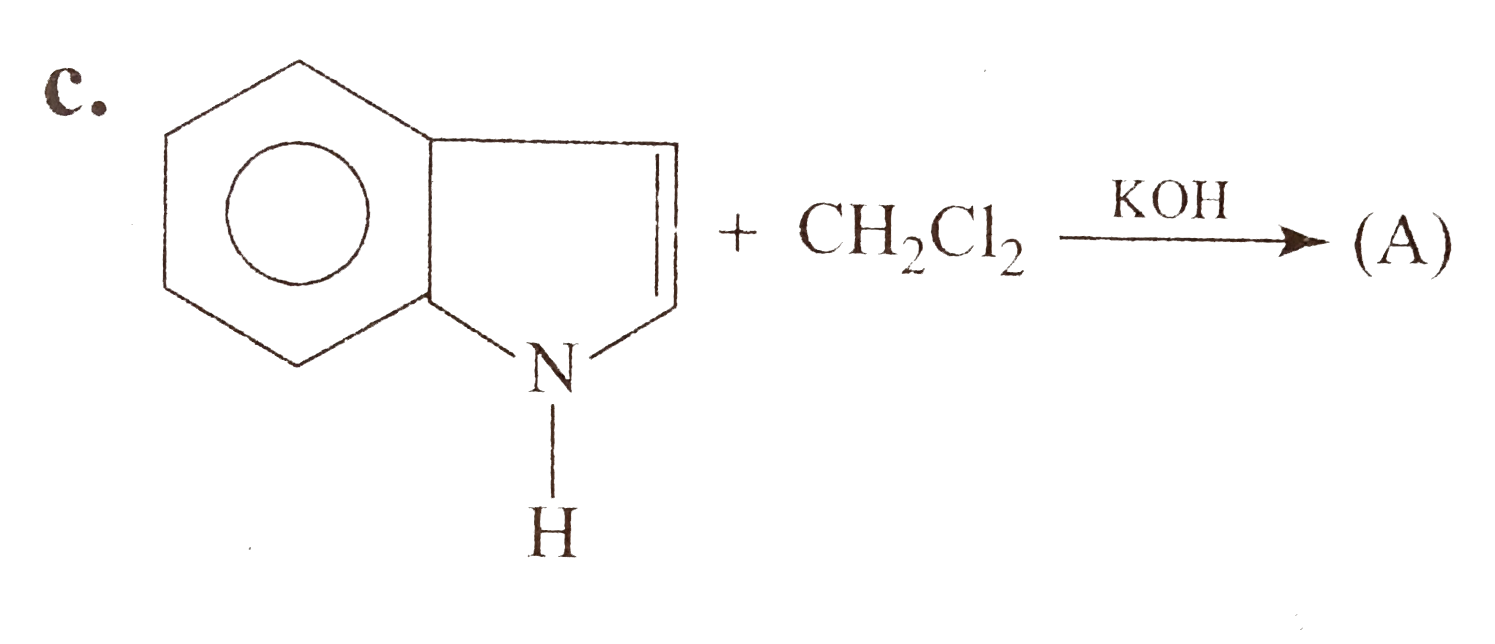
d. `CH_(2)=C=CH_(2)+CH_(2)I_(2)+Zn//Cu rarr (A)`
`e.` `CH_(2)=CH-CH=CH_(2)+CH_(2)N_(2)overset(hv)rarr`
f.
g.
h.
View SolutionGive the stereochemical products of the following :
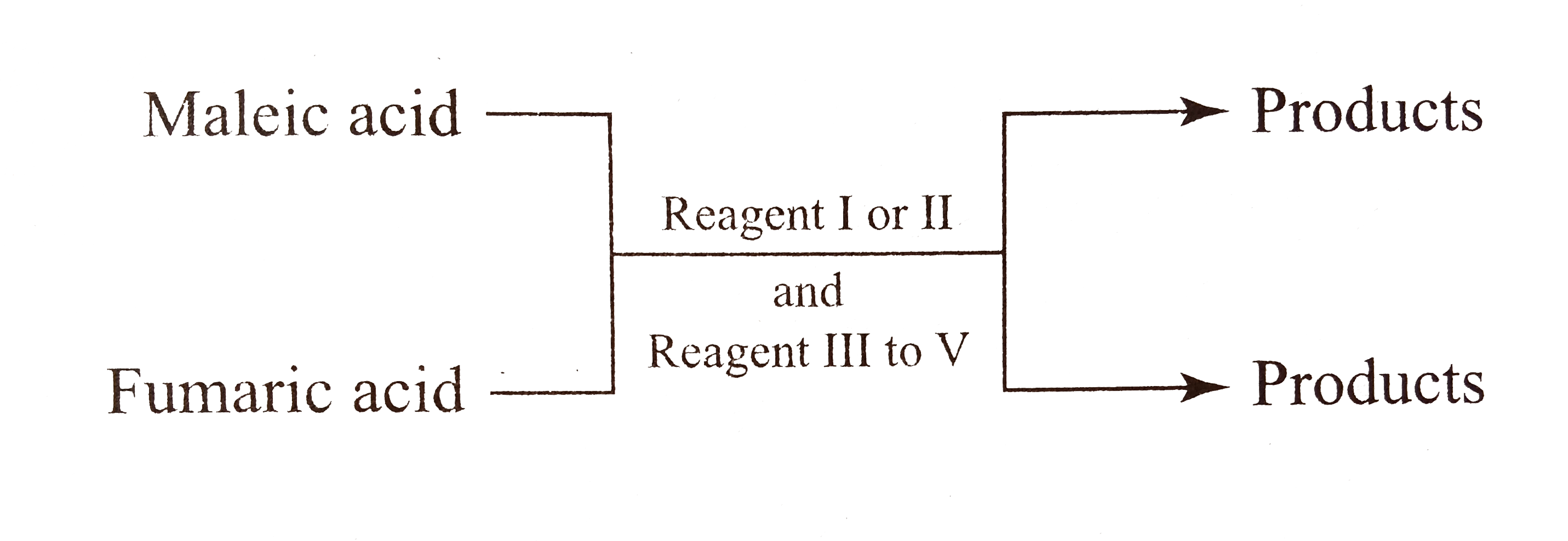
View SolutionComplete the following `:`
`a.`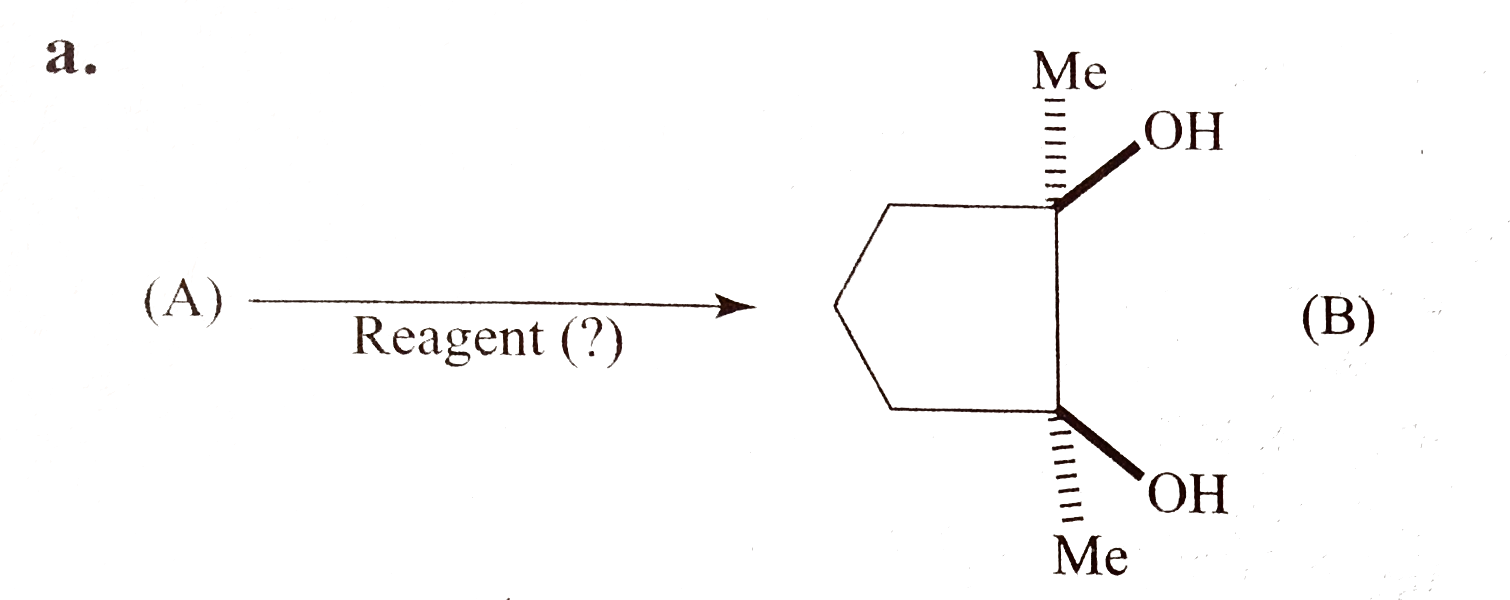
`b.`
`c.`
View Solutiona.

b.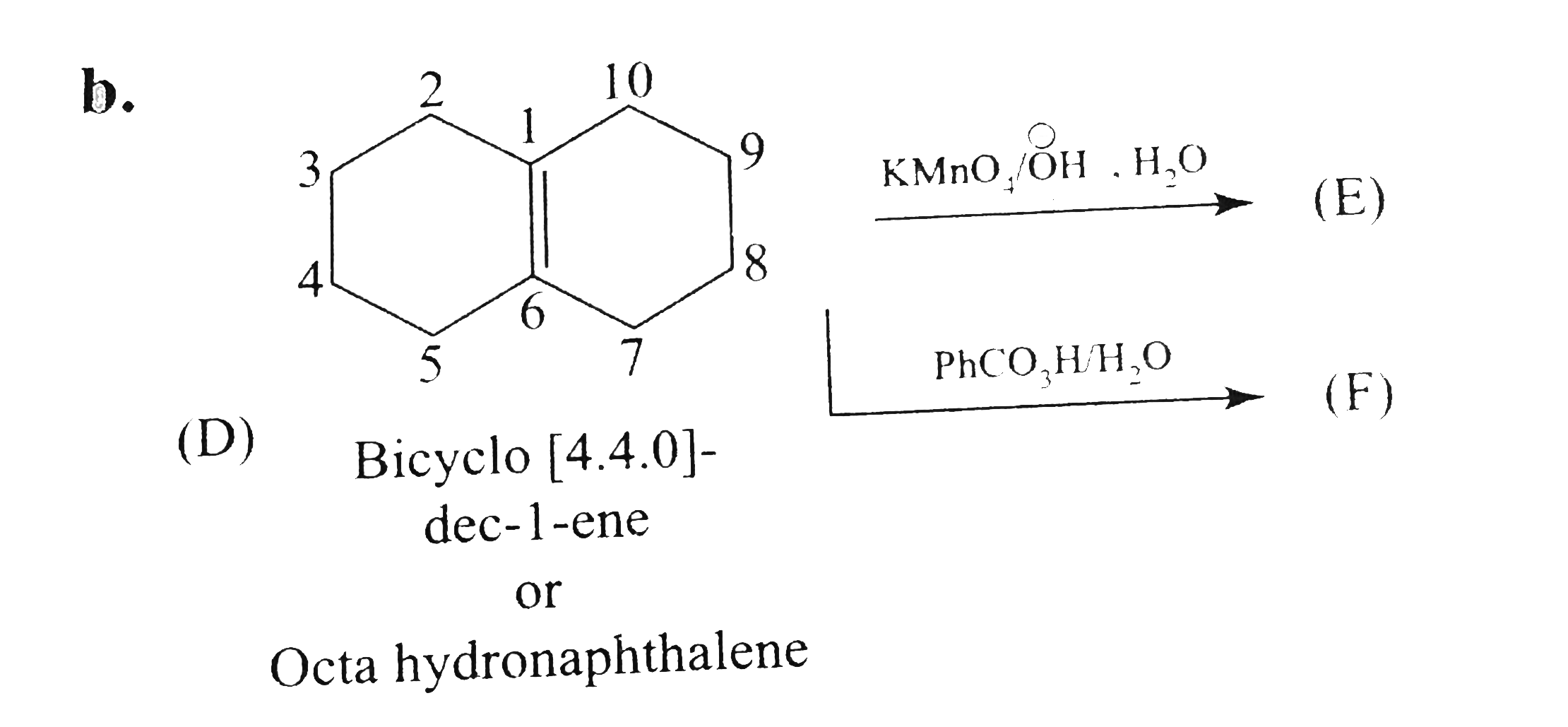
c.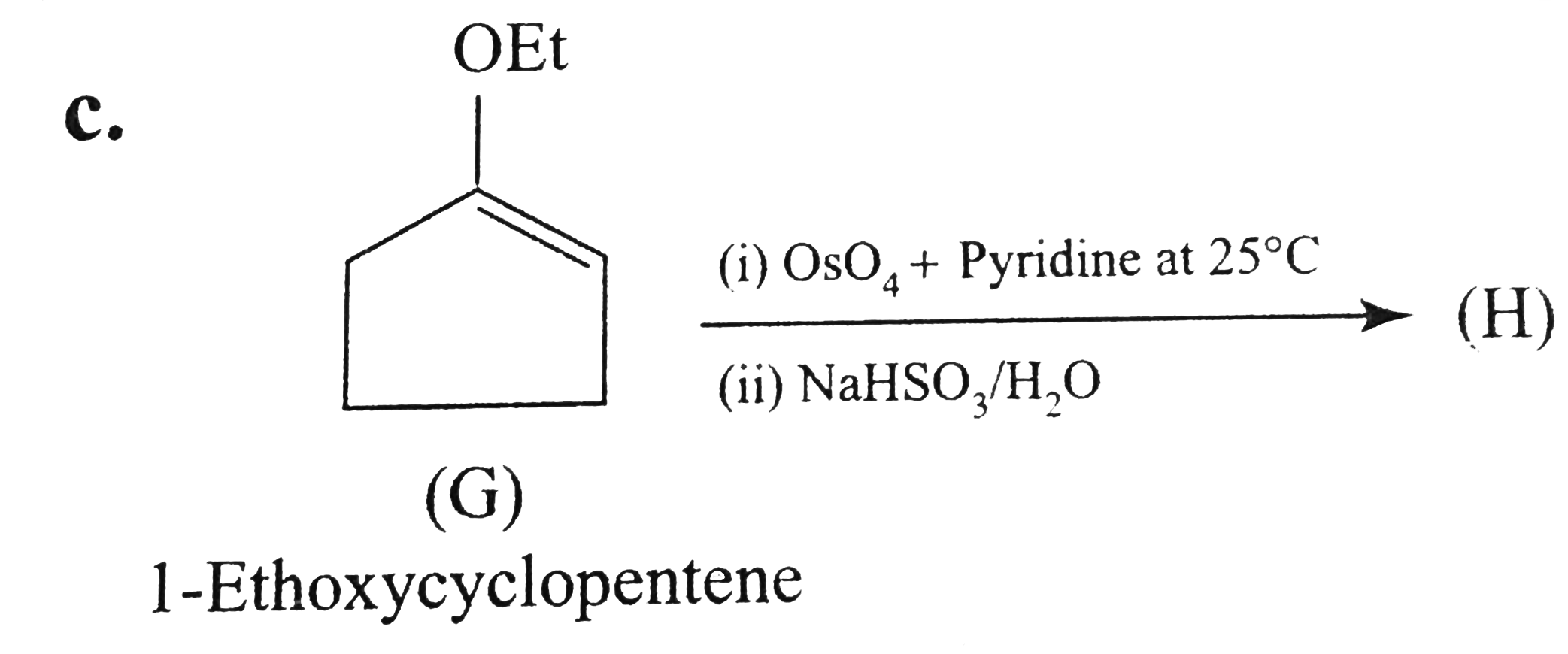
d.
What is the oxidation number of `Mn` in `(B)` and oxidation number of `Os` in `(C)` ?
View SolutionConvert `:`

View SolutionCompound `(A)(C_(12)H_(16))` on oxidation with acideic `KMnO_(4)` solution gives acetone and
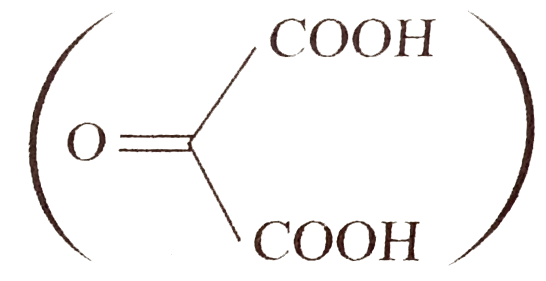 . Identify compound `(A)`.
. Identify compound `(A)`.
View SolutionCompound `(A) ( C_(6)H_(8))overset([o])(rarr)` Malonic acid only. Identify compound `(A)`.
View SolutionCompound `(A)(C_(8)H_(12))` on oxidation gives an acid `B(C_(4)H_(6)O_(2))`. One mole of compound `(A)` reacts with `3 mol` of `H_(2)` in the presence of `Pt` catalyst to give octane. Identify compound `(A)`.
View SolutionA conjugated alkadiene `(A)(._(13)H_(22))` on oxidation with acidic `K_(2)Cr_(2)O_(7))` solution gives butan` 2-`one `(B)` and cyclohexane carboxylic acid `(` cyclohexylmethanoic acid `)(C)` . Identigy compound `(A)`.
View Solution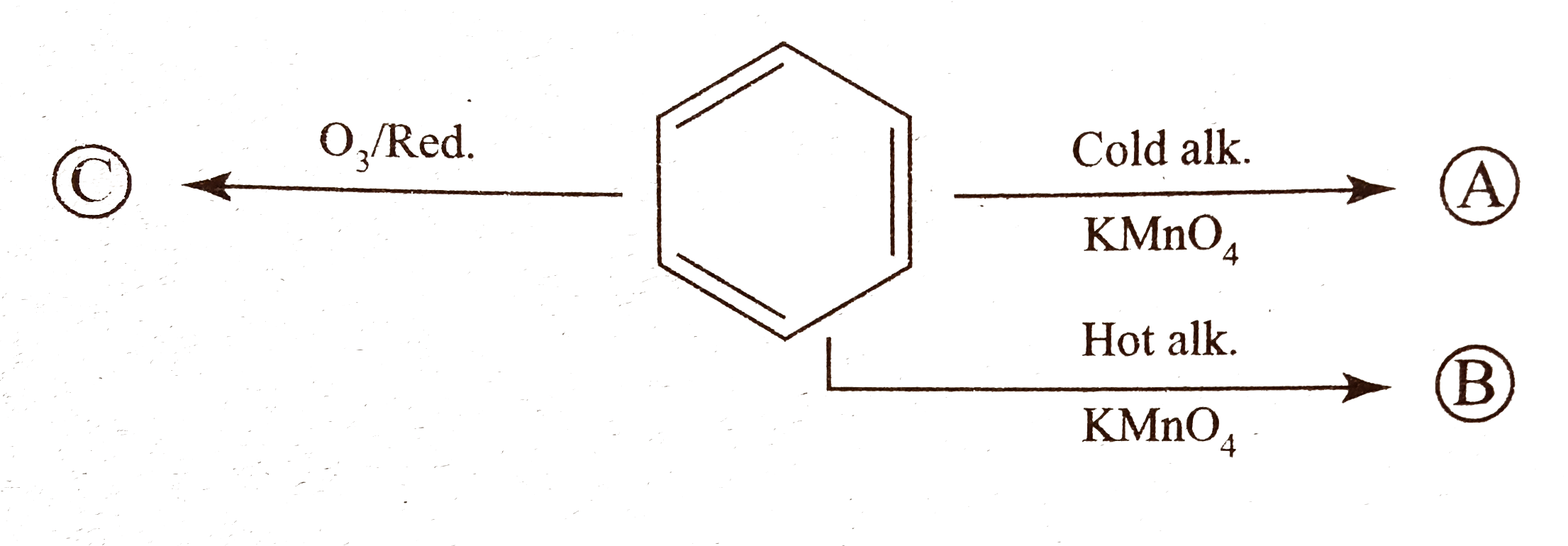
View SolutionGive the products of reductive and oxidative ozonolysis of toluene and` o-, m-, `and `p-`xylenes.
View SolutionIdentify the compound `(A), (B)`, and `(C).`
Compound (A) `(C_(8)H_(12))overset(1mol)underset(of H_(2)//Pd)rarr(B) (C_(8)H_(14))`
`overset("Doesn not show")overset("stereoismerism")underset((C)(C_(8)H_(12)O_(2)))underset("Symmetrical diketone")(darrO_(3)//Ph_(3)P)`
View SolutionGive a chemical test to distinguise between but `-1-`ene and but `-2-`ene.
View SolutionGive a chemical test to distinguish between `1,2-`dibromopropane and `1,3-` dibromopropane.
View Solution
What is compound `(B)` and how is it formed ?
View SolutionHow many isomaric dienes with a six-membered ring are possible of the compound with the molecular formula `C_(7)H_(10)` ?
View SolutionComplete the following reactions `:`
`a.`
`b.`
`c.`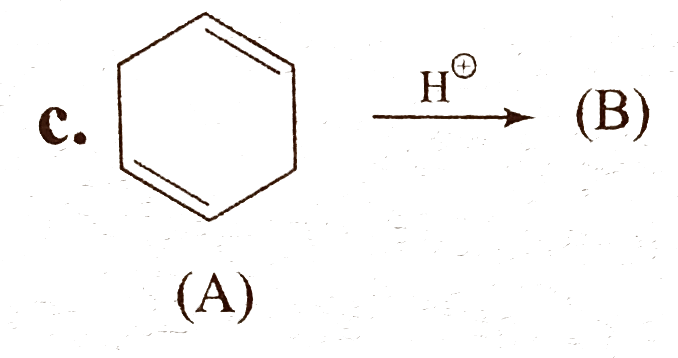
`d.`
`e.`
`f.`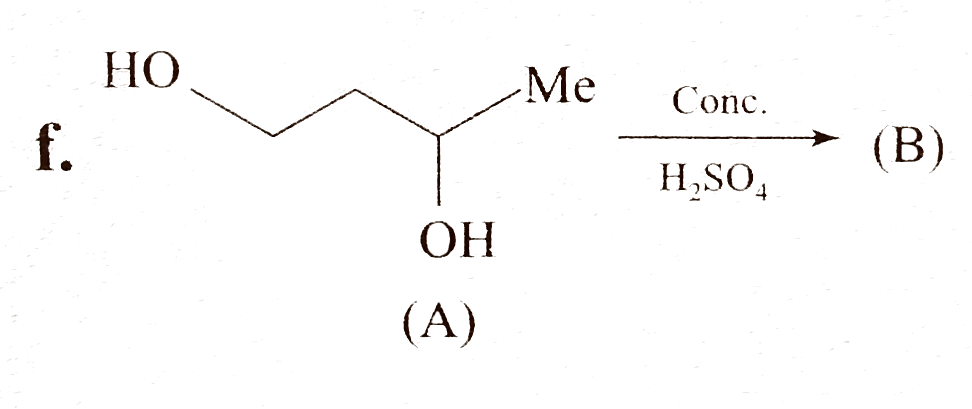
`g.`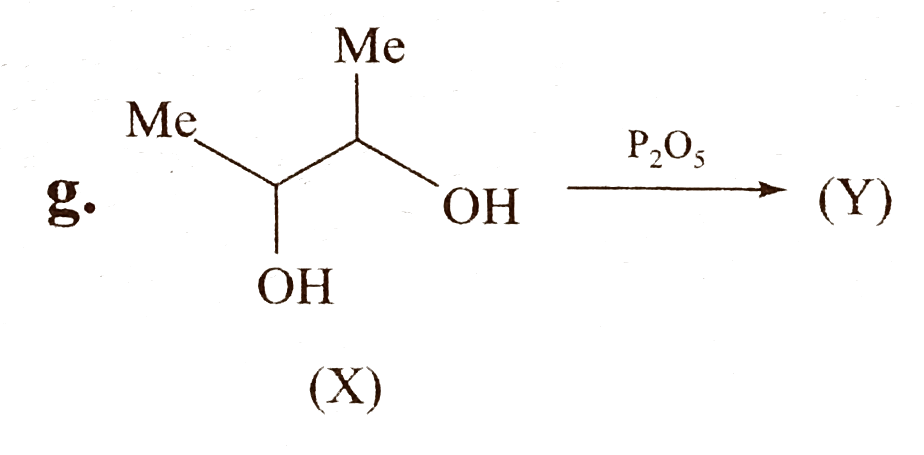 ltbr `h.`
ltbr `h.` 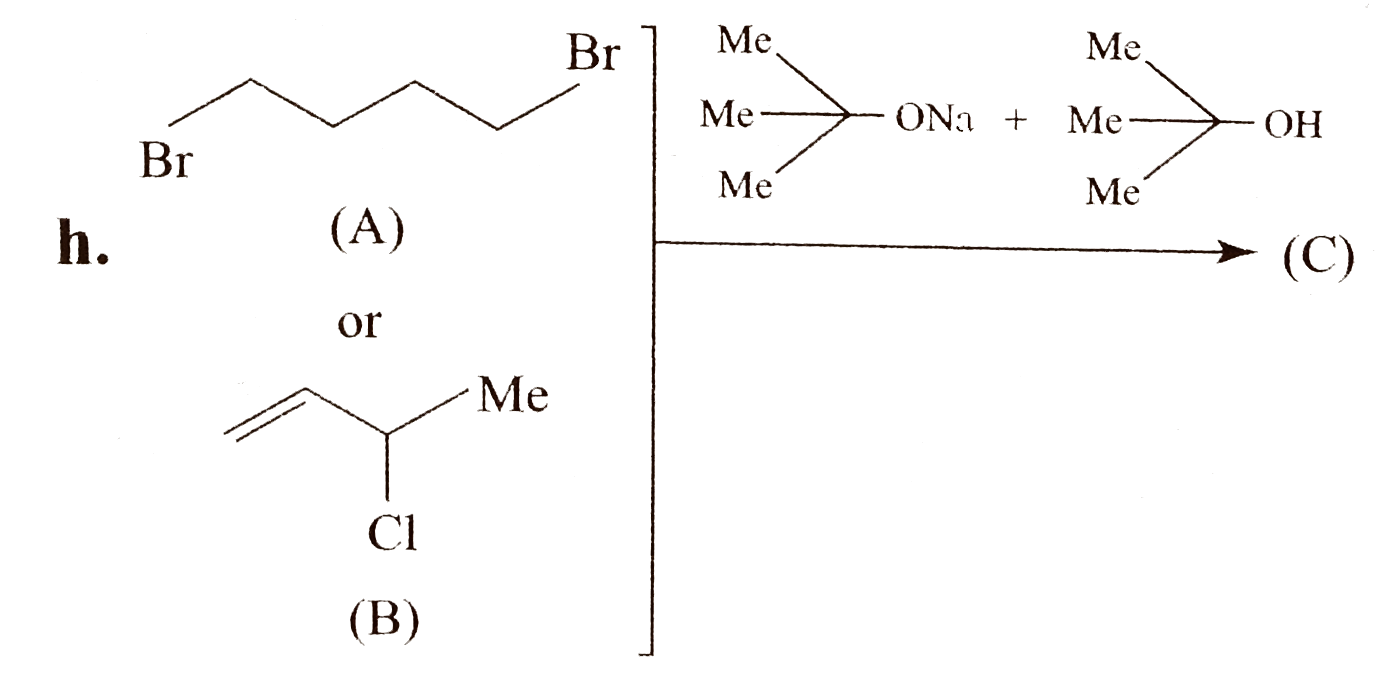
`i.`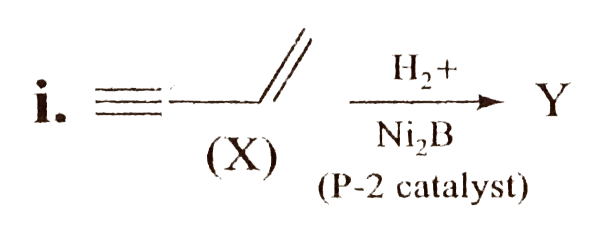
`j. `
`k`.`underset((A))(CH_(2)=C=CH_(2))overset(KNH_(2))underset(underset(underset(underset(C_(2)H_(5)OH)(+))(C_(2)H_(5)ONa))(or))rarr(B)`
View SolutionGive the major products (not stereoisomers) of the following `:`
a.
b.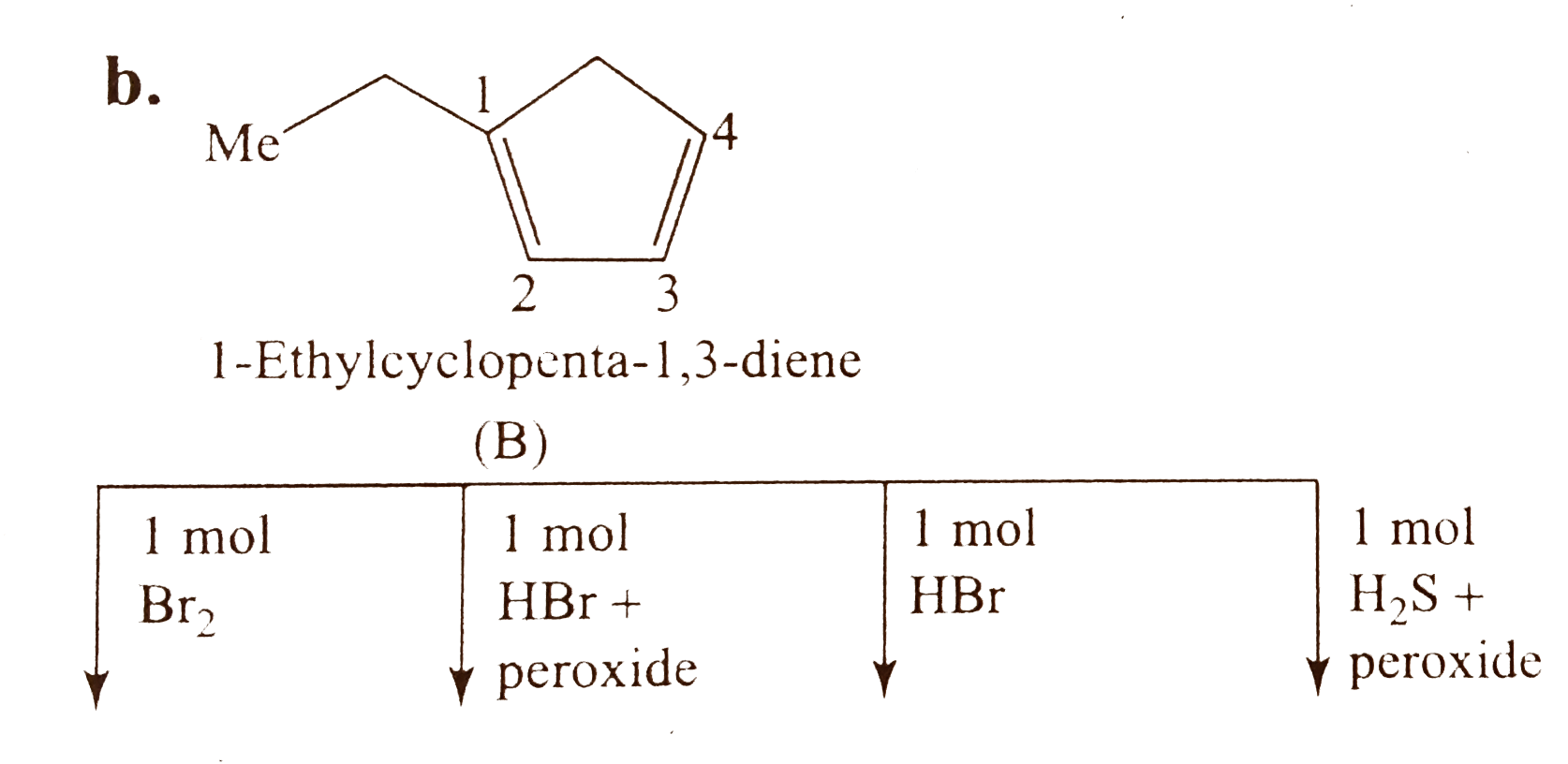 1-Ethylcyclopenta -1,3- diene
1-Ethylcyclopenta -1,3- diene
`c.` Give the major and the minor products`:`
Buta`-1,3-`diene
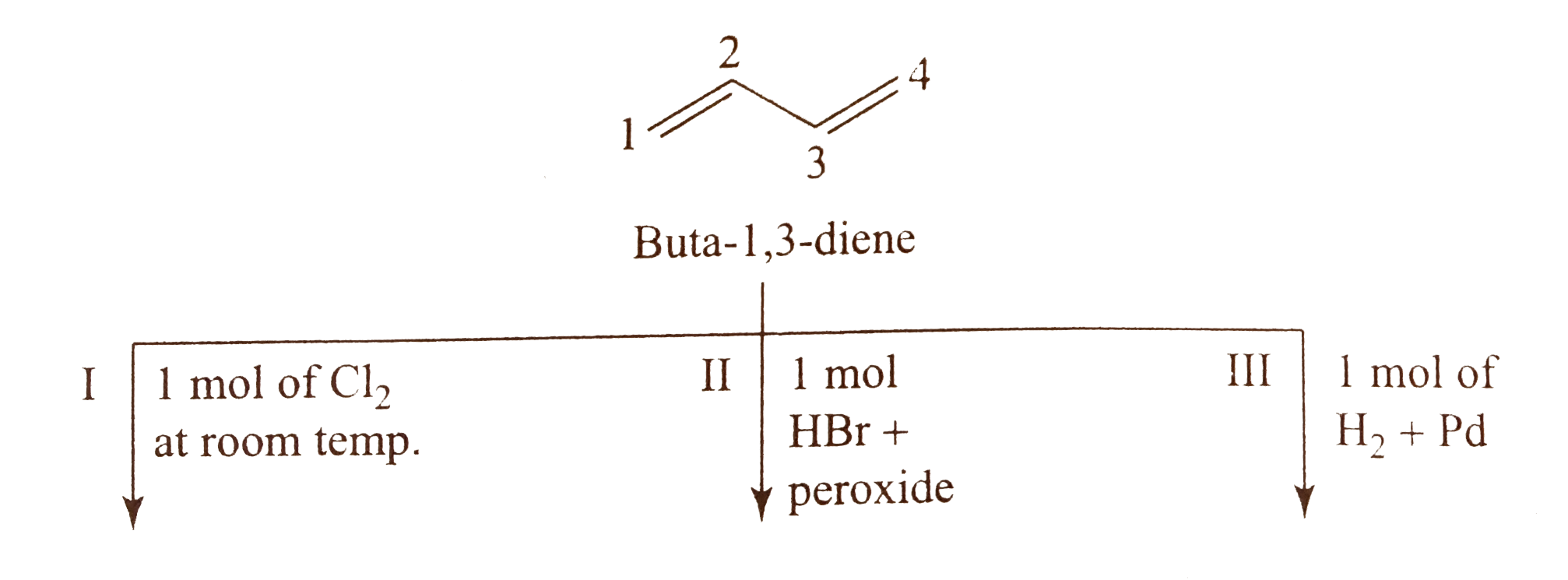
`d.` Cycloocta `-1,3,5-`triene
`e.` Hexa`-2,4-` diene
`f.` Penta `-1,3-`diene
View Solution Products
Products
Write all the possible structures and give the structures of the products that are thermodynamically favoured.
View SolutionIdentify `(A)` to `(F)` :
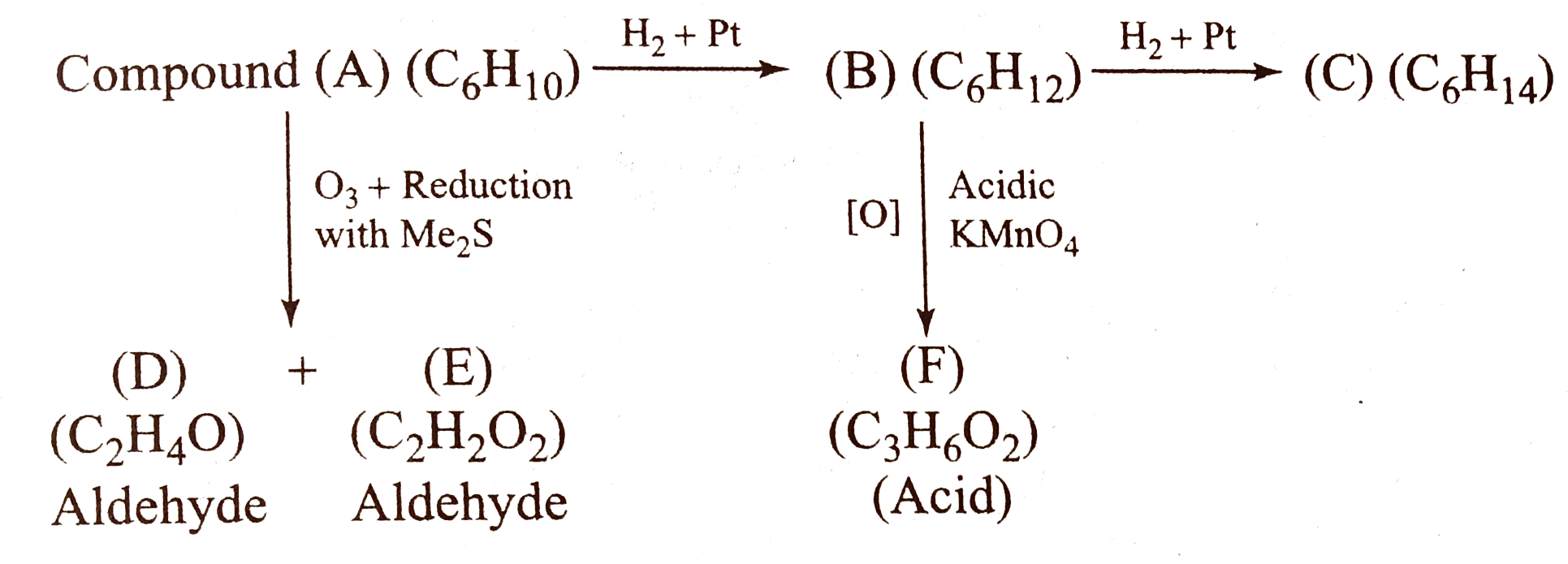
View SolutionDistinguish between the given pairs.
`a.`
`b.`
`c.`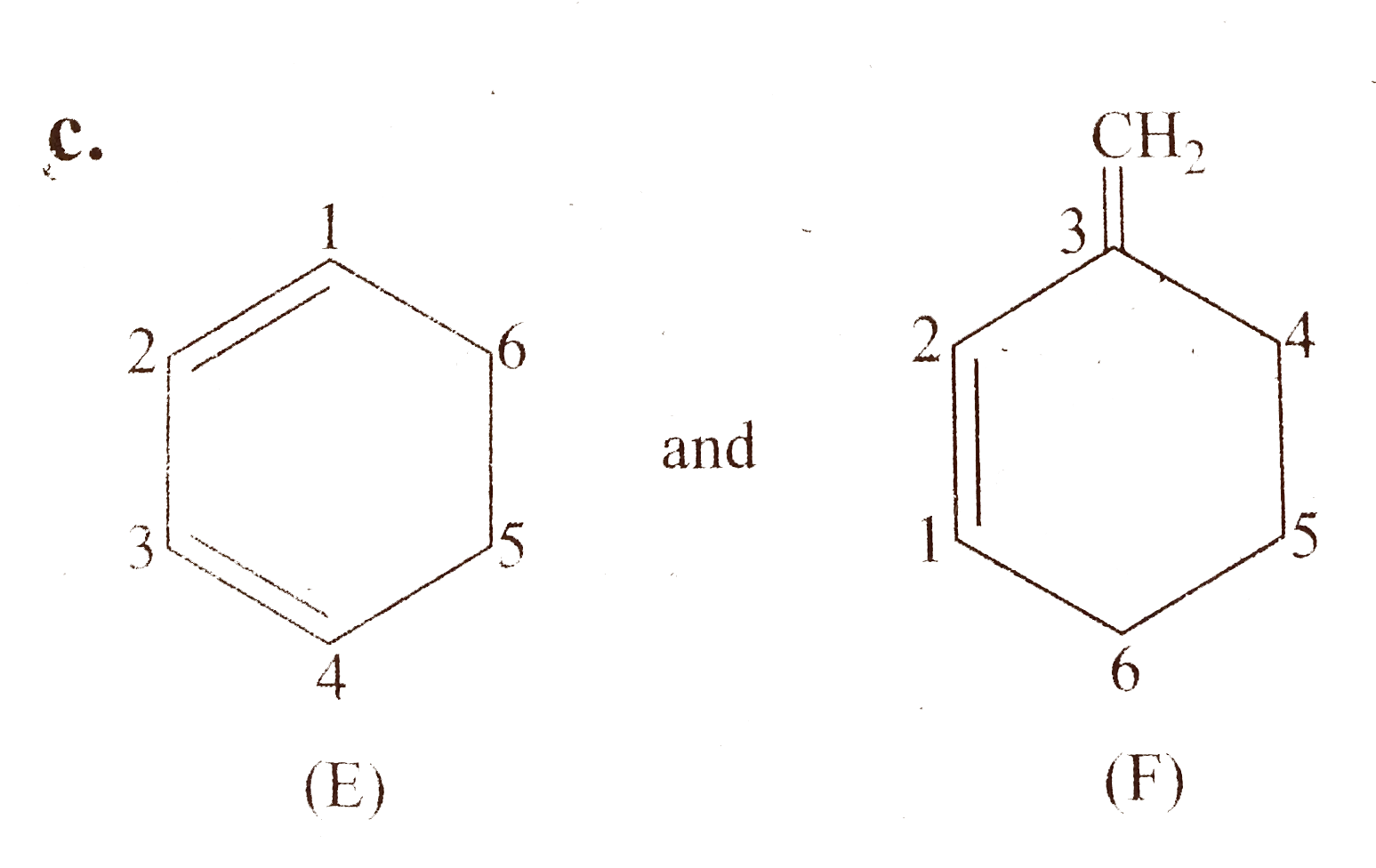
`d.`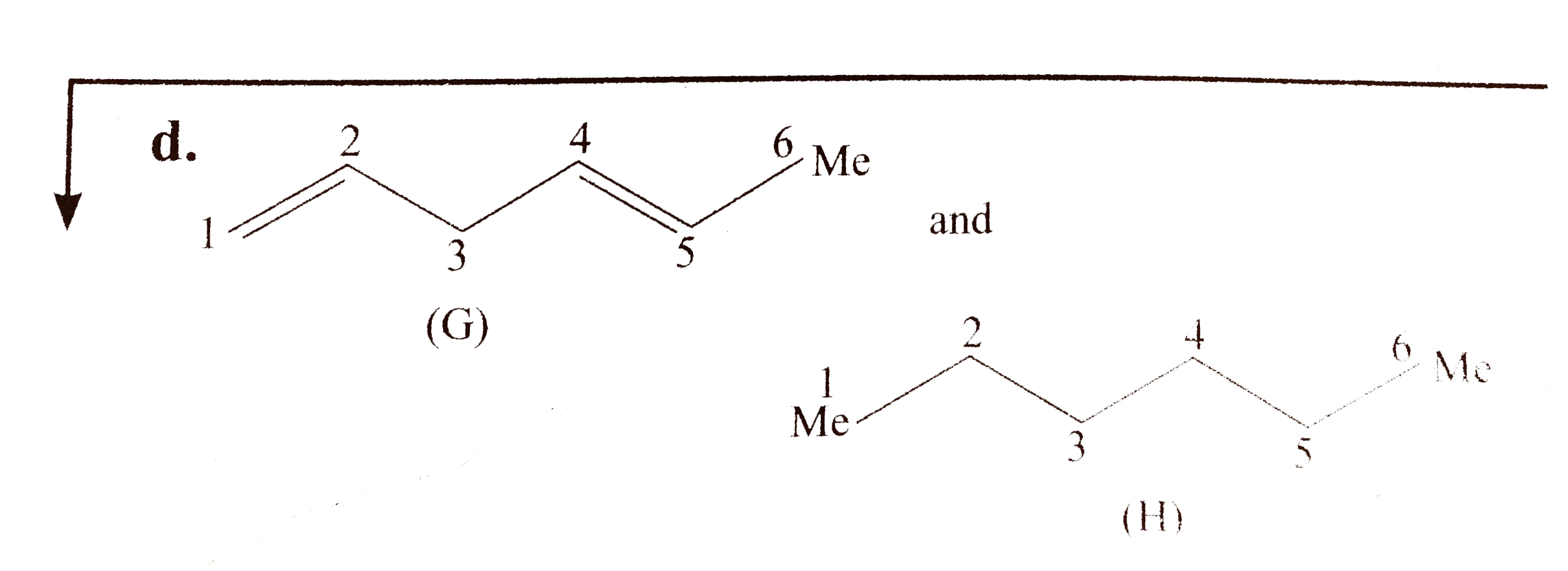
View SolutionGive the major and minor porducts.
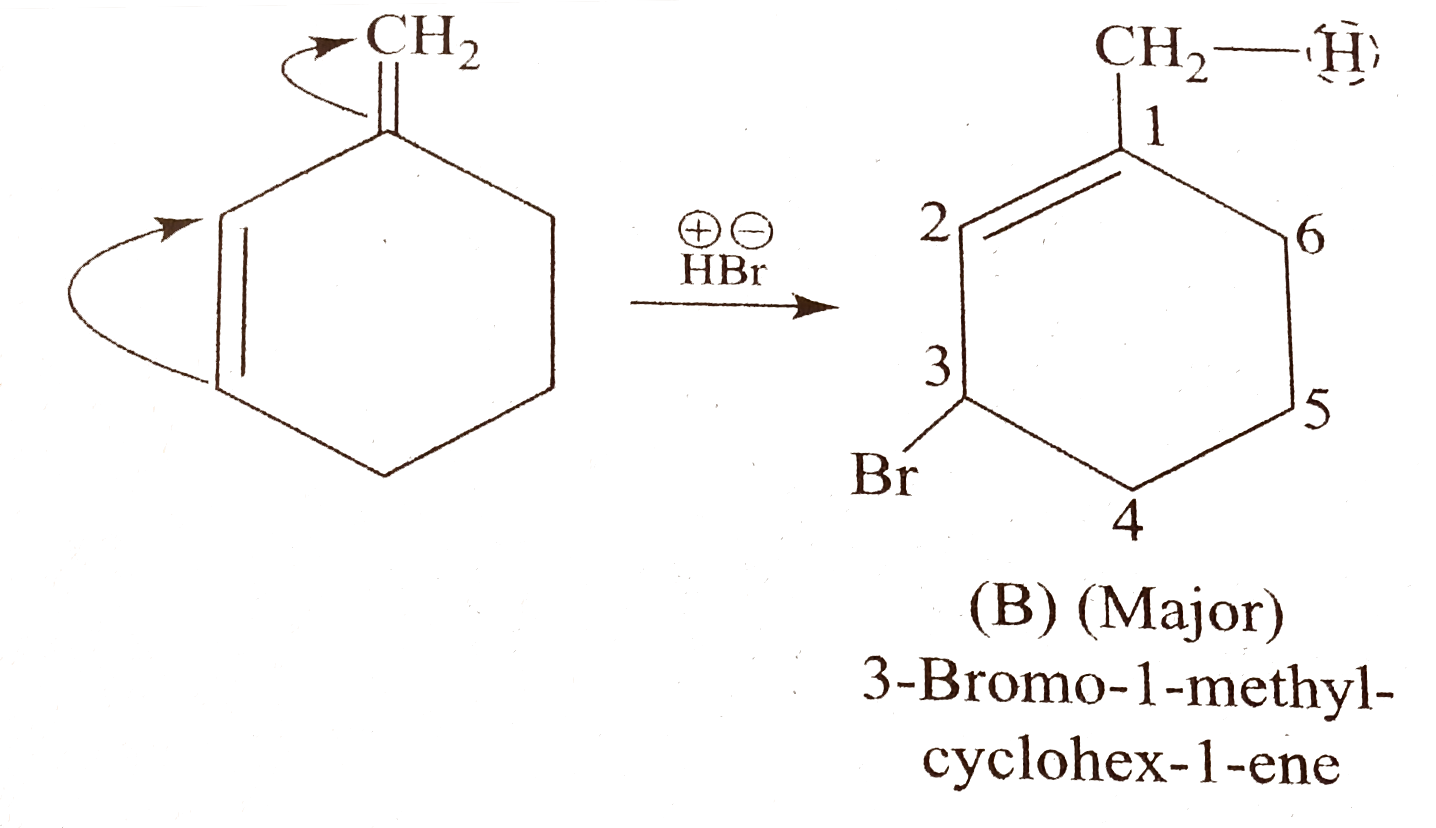
View SolutionGive the name and structrues of six `C` atom cyclic diene with lowest molecular mass that shows only geometrical isomers (diastereomers) and not optical isomers.
View SolutionComplete the following reaction

View Solution
illustration questions and complete solutions for chapter ALKENES AND ALKADIENES of CENGAGE CHEMISTRY (HINGLISH) of Class 11